Japanese–English
Notes: Boldface indicates the heading of an entry and acts as a cross-reference to another entry in the Japanese-English section. Italics is used for foreign words, chiefly Latin names, Japanese words that are not main entries, and for second mention of main-entry terms. In the few cases where a Japanese name follows a Latin one, the Japanese name appears in roman, e.g., Conger myriaster (ma-anago) in the anago entry.
abekawamochi あべかわもち 安倍川餅 grilled cut mochi topped either with sugar and kinako mixed, or with syrup and then kinako.
abura-age あぶらあげ 油揚げ thin deep-fried sliced tofu. An essential ingredient of inarizushi.
aburana あぶらな 油菜 rape Brassica campestris var. nippooleifera. Most important for the oil obtained from its seeds (natane) but the leaves are also used as a green vegetable.
aemono あえもの 和え物 a cooked salad, one of the basic categories of Japanese cuisine. Cooked vegetables such as spinach are dressed with a thick dressing such as sesame paste gently flavored with soy sauce and sugar (goma ae). Hōrensō no goma ae (spinach dressed with sesame), although simple, is one of the outstanding dishes of Japan. Tofu and miso are also used for dressings.
agari あがり 上がり freshly drawn tea, short for agaribana 上がり花. Above all, a sushi-shop term.
agedashi あげだし 揚げ出し deep-fried food such as tofu, nasu, and whitefish eaten with soy sauce seasoned with grated ginger and grated daikon.
agedashidōfu あげだしどうふ 揚げ出し豆腐 tofu from which much of the moisture has been pressed is coated with katakuriko or wheat flour, deep-fried, sprinkled with katsuobushi shavings, and served with grated ginger and daikon in a soy-based sauce such as warishita.
agedōfu あげどうふ 揚げ豆腐 thick deep-fried sliced tofu used in soups, nimono, and many other ways.
agekamaboko あげかまばこ 揚げ蒲鉾 a special kind of kamaboko that is deep-fried. It is called satsuma-age in the Tokyo region.
agemono あげもの 揚げ物 deep-fried food, the best known of which are tempura, kara-age, and furai.
ainame あいなめ 鮎魚女、 鮎並 fat greenling Hexagrammos otakii. A fish found in rocky-shore areas. When very fresh, this soft-fleshed fish can be served as sashimi. Otherwise, it is prepared as teriyaki, nitsuke, or chirinabe.
aji あじ 鰺 jack, horse mackerel Trachurus japonicus. A true jack, this delicious and very popular fish attains a length of up to 30 cm and is available all year but is at its best from spring to autumn. It is served as sashimi, shioyaki, sunomono, and nitsuke.
ajinomoto あじのもと 味の素 brand name for the chemical seasoning monosodium glutamate as marketed by the Ajinomoto company. See also Appendix 14 for monosodium glutamate.
ajishio あじしお 味塩 salt mixed with a chemical seasoning, usually monosodium glutamate. See also ajinomoto.
ajitsuke あじつけ 味付け seasoning, flavor added in some way.
ajitsuke nori あじつけのり 味付け海苔 seasoned laver. See also nori.
akachōchin あかちょうちん 赤堤灯 unpretentious drinking shop displaying a large red paper lantern outside as a kind of pub sign.
akadashi あかだし 赤出し miso shiru made with akamiso, in particular hatchō miso and other all-soybean misos.
akagai あかがい 赤貝 cockle, ark shell, blood clam Anadara broughtonii. This clam can reach a diameter of 12 cm and is at its best in spring. The freshest ones are eaten raw with a dipping sauce of soy sauce and wasabi, or sanbaizu. They are also served on sushi, put into soups, prepared as namasu, nitsuke, and yakimono, and can be baked in the shell.
akajiso あかじそ 赤紫蘇 red perilla. See also shiso.
akamiso あかみそ 赤味噌 See Appendix 6.
akebi あけび 木通、 通草 akebi Akebia quinata. An autumn fruit, fairly insipid though it can be sweet. The outer shell is purple and the shape of a huge pea pod. Rarely seen in shops.
amadai あまだい 甘鯛 tilefish (a kind of sea bream) Branchiostegus japonicus. The flesh of this food fish of western Japan is somewhat watery.
amaebi あまえび 甘海老 pink shrimp, northern shrimp Pandalus borealis. See also ebi.
amaguri あまぐり 甘栗 See kuri.
amai あまい 甘い sweet.
amami あまみ 甘味 sweetness. As one of the five basic tastes, the word is usually pronounced kanmi. See also kanmi.
amanatsu あまなつ 甘夏 common name for the orange-type citrus fruit kawano natsu daidai かわのなつだいだい 川野 夏情 Citrus natsudaidai. It is a variety of natsumikan that ripens earlier (in February and March) and is less sour than other varieties.
amazake あまざけ 甘酒、 醴 a hot drink made by mixing cooked rice with water and rice kōji and holding at from 50 to 60°C for between twelve and twenty-four hours. It is sweetened and often flavored with ginger, and is particularly drunk for colds and sore throats and on New Year visits to shrines and temples. A quicker but inferior version is made from sakekasu.
ame あめ 飴 candy, toffee, a kind of higashi. See also mizuame.
ami あみ 醤蝦、 海糠魚 opossum shrimp, mysis Neomysis spp. An extremely small shrimp, not longer than 2 cm at the most. It is usually made into shiokara, but is also dried and prepared as tsukudani.
amiyaki あみやき 網焼き grilling done on a griddle (yakiami). See also yakimono.
an あん 餡 paste made from starchy pulses and sugar and mostly used as a filling for wagashi. The commonest type is red and made from azuki and can be either sieved as koshian, or unsieved as tsubuan. Shiroan, which is off-white, is made from white kidney beans. It can also be made from potatoes, sweet potatoes, chestnuts, and lily roots.
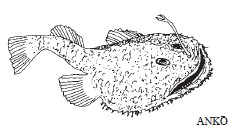
anago あなご 穴子 conger eel Anago anago (goten-anago) and Conger myriaster (ma-anago). This sea eel can reach up to 90 cm in length, but is usually taken at 30 to 40 cm. At its best in July and August, it makes wonderful nigirizushi and is also prepared as kabayaki, tempura, nabemono, sunomono, chawan mushi, and mirinboshi.
ankake あんかけ 餡掛け sauce made by mixing kuzu flour or katakuriko with water or vegetable stock and heating till it thickens.
ankō あんこう 鮟鱇 angler fish 1. Lophiomus setigerus 2. Lophius litulon. A fearsomely ugly but excellent tasting fish that grows from 1 to 1.5 m and is at its best in winter. A favorite way of eating it is simmered in warishita as ankōnabe. It is also made into a soup with red miso. The liver is served in vinegar.
anmitsu あんみつ 餡蜜 mitsumame with an. A sweet dish popular at kanmidokoro.
anzu あんず 杏子、 杏 apricot Prunus armeniaca (rather than Armeniaca vulgaris “ansu”). Excellent apricots are grown in the Japan Alps, but they are not readily available, especially in the warmer parts of Japan, and most of the crop is made into apricot jam. For the Japanese apricot, see also ume.
aojiso あおじそ 青紫蘇 green perilla. See also shiso.
aonori あおのり 青海苔 green laver Enteromorpha. See also nori.
aoyagi あおやぎ 青柳 See bakagai.
aradaki あらだき 粗炊き a simmering of large fish, usually such fish as tai or buri that is not fresh enough to be eaten as sashimi or grilled. The head and the body still with its bones are simmered in stock flavored with soy sauce, saké, sugar, and mirin. Vegetables such as gobō are sometimes added.
arai あらい 洗い a style of sashimi in which slices of fish are washed in cool water, then plunged into iced water for a minute, and drained. It is a particularly useful treatment for fish such as koi that might have a muddy taste.
arame あらめ 荒布 arame Eisenia bicyclis. A non-cultivated seaweed that is dried in the wind. It must be harvested young and is tasty when fried or cooked with rice or with other foods.
arani あらに 粗煮 See aradaki.
arare あられ 霰 little rice crackers resembling hailstones. They are eaten with drinks as tsumamimono.
asakusanori あさくさのり 浅草海苔 purple laver Porphyra tenera. See also nori.
asanomi あさのみ 麻の実 Indian-hemp seeds Cannabis sativa. These sterilized seeds of marijuana, all imported, are not at all narcotic. They do not taste of much either, but are traditional in the seven-spice mixture shichimi tōgarashi, for which they are parched and added whole to the mix.
asari あさり 浅蜊、 蛤仔 short-necked clam Tapes philippinarum. These clams are eaten from winter to early spring but should never be eaten in late spring or summer. Nor should they be eaten raw. They are served in the shell in miso shiru, and the flesh is served as tsukudani, sunomono, kakiage, and in zōsui.
asatsuki あさつき 浅葱 asatsuki chive Allium ledebourianum. Very similar to nira and wakegi, it is shallow-fried as a vegetable, used in nabemono, and as an herb flavoring with sashimi of fugu (fugusashi).
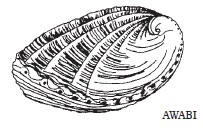
atsuage あつあげ 厚揚げ thick sliced tofu fried briefly in very hot oil so that the inside remains unchanged. With abura-age the slices are thinner and fried right through. Atsuage can be eaten on its own with soy sauce flavored with ginger, and is also served as nimono, itamemono, aemono, and o-den. It is also called nama-age.
awa あわ 粟 foxtail millet Setaria italica. Along with hie, foxtail millet used to be eaten by poorer Japanese as a cheap substitute for rice. It is grown in Kyushu and Shikoku and may be cooked on its own or mixed with rice. It must be eaten hot, since it goes hard when cold. It is made into millet cakes (awa-mochi), millet balls (awadango), and millet candy (awa-ame).
awabi あわび 鮑 abalone Nordotis spp. A favorite but expensive shellfish. Live, it is eaten raw as sashimi, its crisp chewiness being highly appreciated. It is also steamed, boiled, and cooked as ishiyaki. At its best in May and June.
awasemiso あわせみそ 合わせ味噌 a mixture of different kinds of miso. It is considered to make the most delicious miso soup.
ayu あゆ 鮎 sweetfish Plecoglossus altivelis. A river fish growing up to 30 cm in length but usually 12 to 15 cm on the market. It is caught between June and August, traditionally with trained cormorants and flares at night. Drinking parties are held on board the fishing boats, with the ayu out of the cormorants’ throats straight into the eaters’ mouths via the grill. Today it is mainly caught by rod and line or trapped. Ayu has a particularly good flavor and is usually grilled as shioyaki and served with tade su as a dip. The late-season fish, ochiayu, heavy with roe, is considered the tastiest.
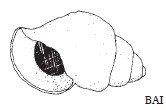
azuki あずき 小豆 azuki (adzuki, aduki) bean (pronounced a zoo key) Vigna angularis. A little red bean of which the Japanese are especially fond. It is an ingredient of sekihan and from the earliest times has been cooked with rice. An, the sweet paste used as a filling for many Japanese cakes and confections, is mostly made from azuki and sugar, which are also ingredients for shiruko.
bai ばい 蛽、 海蠃 a species of whelk Babylonia japonica Family Buccinidae. This kind of whelk, also called baigai, is from 7 to 10 cm in length, in girth about 7 cm. The flesh is removed from the shell, boiled, and made into sunomono, aemono, and tsukudani.
baikingu ryōri バイキングりょうり バイキング料理 buffet. In 1958 the Imperial Hotel in Tokyo opened a smorgasbord restaurant. This buffet style of food service has come to be known as baikingu, the Japanese pronunciation of viking, through association with the Swedish smorgasbord. Very popular for receptions at hotels, which often also serve breakfast in this way.
bai niku ばいにく 梅肉 sieved flesh of umeboshi. Used as a topping and a dip, it has sharp, salty flavor that offsets bland foods such as tofu. It is sold in bottles.
bakagai ばかがい 馬鹿貝 hen clam, surf clam, round clam Mactra chinensis. Similar in shape and size (4 cm wide, 6.5 cm thick, and 8.5 cm long) to the hamaguri clam, this shellfish is widely distributed throughout Japan. It is eaten as sashimi, sunomono, and kakiage. The red peduncle is also eaten as sashimi and sunomono. Baka means fool, and since many object to the use of such a term, bakagai is sometimes called aoyagi 青柳, after a village in Chiba Prefecture where it is taken in abundance.
bancha ばんちゃ 番茶 common green tea. See also Appendix 12.
barazushi ばらずし ばら鮨、 ばら寿司 See Appendix 11.
bareisho ばれいしょ 馬鈴薯 See jagaimo.
ba sashi ばさし 馬刺 horse-meat sashimi Equus caballus. A specialty of Kumamoto and Nagano prefectures, horse meat is sliced thinly and served raw with garlic and ginger-flavored soy sauce.
bateira ばていら 馬蹄螺 turban shell Omphalius pfeifferi. A conical-shaped shellfish about 5 cm tall and 5.5 cm round. It is tasty when boiled and served as sunomono, aemono, or nimono.
battera バッテラ from Portuguese bateira, meaning boat-shaped. A specialty of Osaka, this sushi is made in a special wooden box in which sushi rice is pressed with vinegared mackerel topped with a transparently thin slice of konbu. See also saba-zushi.
benishōga べにしょうが 紅生姜 See shōga.
benitade べにたで 紅蓼 water pepper Polygonum hydropiper forma purpurascens. Also called murasakitade, the extensively cultivated little purple leaves have a peppery flavor. They are often placed next to the wasabi for mixing with soy sauce as a dip for sashimi. Parched tade is used as a garnish for soups.
benizake べにざけ 紅鮭 sockeye salmon, red salmon Oncorhynchus nerka. A northern Pacific fish of 50 to 60 cm in length, it mostly comes to Japan frozen. The bulk is salted and sold for grilling. It is also used in Western-style cooking.
bentō べんとう 弁当 boxed meal consisting of rice, pickles, and any number of accompanying foodstuffs. Most bentō are prepared at home to be taken to school or the workplace for lunch. There is also a large industry preparing and selling bentō at all times of day or night, often with the rice put in hot at the time of sale. There are also restaurants, especially in Kyoto, that specialize in bentō, which may extend beyond the box and not actually be portable. Perhaps the best-known kind of bentō is the ekiben えきべん 駅弁, sold at all major railway stations throughout Japan, usually with some distinct local touch. Makunouchi bentō まくのうちべんとう 幕の内弁当 is a good standard bentō, while shōkadō bentō しょうかどうべんとう 松花堂弁当 is high class and elegant.
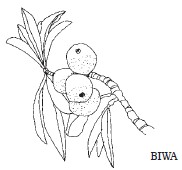
bera ベら 倍良、 遍羅 Family Labridae includes a large number of very colorful fish, especially sasanohabera (Pseudolabrus japonicus), and several kinds of wrasse called kyūsen. As well as being the basic ingredient of kamaboko, it is prepared as nitsuke, kara-age, and nanbanzuke. Also called gizami.
bettarazuke ベったらづけ ベったら漬け daikon pickled in kōji. It has a sweet flavor and alcoholic aroma. Highly recommended.
biifun ビーフン 米粉 Chinese rice noodles. Popular in Japan, but not strictly part of Japanese cuisine.
biwa びわ 枇杷 loquat, Japanese medlar Eriobotrya japonica. A very bland, early-summer fruit, eaten fresh. It may also be canned, and used in jams, jellies, and liqueurs.
bōfū ぼうふう 防風 1. common abbreviation of hama bōfū. 2. root of Ledebouriella seseloides, one of the ingredients of toso.
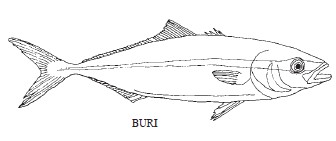
bora ぼら 鯔、 鰡 striped mullet, (British) grey mullet Mugil cephalus cephalus. Growing up to 80 cm in length, this fish is suitable for sashimi only when extremely fresh, since it feeds on mud and green algae and deteriorates very quickly. It is best eaten as gyoden ぎょでん 魚田 (fish dengaku), teriyaki, or misozuke. The female roe of bora is made into karasumi. See also chinmi.
botan ebi ぼたんえび 牡丹海老 botan shrimp Pandalus nipponensis. See also ebi.
botan nabe ぼたんなベ 牡丹鍋 nabemono with wild boar (inoshishi) as the main ingredient. Botan is Japanese for peony.
budō ぶどう 葡萄 grape Vitis spp. Eaten fresh in late summer and autumn, the best grapes are a considerable luxury. There is a vigorous wine industry in Japan, and though the number of discriminating consumers is increasing, they tend to prefer imported wines.
buntan ぶんたん 文旦 pomelo, shaddock Citrus grandis. The largest of the citrus fruits, it is grown in Kyushu and Shikoku. It is eaten raw and is similar to the grapefruit, though not as juicy. The candied peel is a popular delicacy. Buntan is also called zabon.
buri ぶり 鰤 yellowtail, Japanese amberjack Seriola quinqueradiata. A large fish about 1.3 m in length and weighing about 15 kg, it is highly regarded and is particularly good as sashimi and also very good grilled and as teriyaki. It is at its best in autumn and winter and is extensively cultivated artificially, as is its younger form (hamachi). In western Japan, buri is the favored fish at New Year. It is first eaten as sashimi, then in zōni, later grilled, especially as teriyaki, and finally fixed as aradaki.
buta niku ぶたにく 豚肉 pork Sus scrofa var. domesticus. Pork is principally eaten as tonkatsu, but also appears in yakiniku and nimono.
butsugiri ぶつぎり ぶつ切り roughly chopped fish or meat on the bone, though fish may be filleted. It is mostly used in soups and nabemono.
cha ちゃ 茶 tea Camellia sinensis (otherwise Thea sinensis). Introduced from China at the end of the sixth century, Japanese tea is green tea, ryokucha りょくちゃ 緑茶, a term that indicates the leaves are dried without fermentation. This is achieved by sterilizing the leaves with steam before they are dried. They may be powdered for making matcha for the tea ceremony, or infused with hot (rather than boiling) water, in one of several grades. The best is gyokuro, next is sencha, and the ordinary tea for daily use is bancha, which, when freshly toasted, becomes hōjicha. See also appendices 12 and 13.
chabudai ちゃぶだい 卓揪台 low table used without chairs for serving food and drinks in a Japanese-style room. Such tables have been used only since the beginning of the Meiji era (1868) and at first were often round. The legs are often collapsible for convenience of storage. The word chabudai is rather old-fashioned, being largely replaced by zataku.
chāhan チャーハン 炒飯 Chinese-style name for yakimeshi.
cha kaiseki ちゃかいせき 茶懐石 the highly refined style of food associated with the tea ceremony. Since it is not desirable to drink strong matcha on an empty stomach, the practice arose of serving a meal beforehand. The menu should emphasize the season, and is based on rice with ichijū sansai. The meal starts with a tray of rice, soup, and mukōzuke, followed by wanmori (the cha kaiseki term for nimono) and yakimono. Hashiarai (a clear suimono soup to “wash the chopsticks”) is then served with hassun, usually two chinmi, one from the mountains (e.g., iwatake) and one from the sea (e.g., karasumi). Finally, kō no mono is served with yutō (hot washings of the rice pot served in a yutō, a lacquerware container shaped like a teapot without a handle).
chankonabe ちゃんこなべ ちゃんこ鍋 nabemono that is supposed to fatten up sumo wrestlers. Basically a kind of mizutaki, it consists of soup made with roughly chopped chicken on the bone, in which seasonal vegetables, chicken, fish, and tofu are cooked and then dipped in a mixture of soy sauce and vinegar flavored with finely sliced negi. Traditionally the flesh of quadrupeds was not used, since being down on all fours means defeat in sumo. However, in recent years this custom has not been strictly observed.
chanpon チャンポン 1. a famous local dish of Nagasaki. A selection of pork, squid, prawns, oysters, and fish is fried in ample lard along with thinly sliced onion, carrot, cabbage, and other vegetables, and is then served in a large bowl containing lightly cooked Chinese noodles and soup made from roughly chopped pork and chicken on the bone. 2. the practice of mixing Japanese and Western drinks during the same drinking session.
chasen ちゃせん 茶筅、 茶筌 delicate bamboo whisk used for making matcha. These whisks are a special product of the town of Takayama in Nara Prefecture. There are also electric ones for people with weak wrists.
chāshū チャーシュー 叉焼 sliced roast pork served with rāmen.
chawan ちゃわん 茶碗 bowl, usually made of china or pottery for serving food, especially rice, and matcha.
chawan mushi ちゃわんむし 茶碗蒸し steamed savory custard made of egg and dashi. It usually contains chicken, prawns, ginkgo nuts, kamaboko, yurine, and mitsuba, and is steamed in special china cups with lids. Well-liked by all.
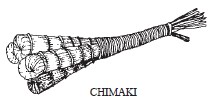
chikuwa ちくわ 竹輪 paste of fish (surimi), starch, and egg white, with salt, sugar, and other seasonings, formed into sausage shapes on skewers, and steamed or grilled. Among many uses, it makes an agreeable tsumamimono.
chimaki ちまき 粽 mochi made of glutinous or non-glutinous rice or rice flour wrapped in bamboo leaf and steamed or boiled. It is particularly eaten on Boys’ Day, May 5, because of its phallic symbolism. May 5 is now usually called Children’s Day.
chingensai チンゲンサイ 青梗菜 pak choy rape, bok choy Brassica campestris var. chinensis. Useful all-purpose green vegetable of Chinese origin, it is boiled or sautéed.
chinmi ちんみ 珍味 rare and unusual food, or food regarded as a great delicacy or luxury, such as uni, konowata, and karasumi, the “three great chinmi” (tenka no sandai chinmi 天下の三大珍味) of the Edo period (1603–1868).
chinpi ちんぴ 陳皮 dried peel of citrus fruit such as mikan, daidai, or yuzu. It is an ingredient of shichimi tōgarashi.
chinu ちぬ 茅渟 black bream Acanthopagrus schlegeli. See also kurodai.
chirashizushi ちらしずし 散らし鮨、 散らし寿司 See Appendix 11.
chirimenjako ちりめんじゃこ 縮緬雑魚 small young sardines and especially anchovies, less than 3 cm long, called shirasu in eastern Japan. After they are boiled and then dried, they are called chirimen in western Japan and shirasuboshi in eastern Japan. They can be made into aemono with grated daikon, and provide a good dietary source of calcium.
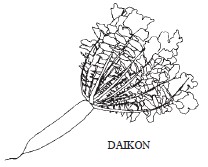
chirinabe ちりなベ ちり鍋 nabemono in which fish, tofu, and vegetables are simmered in water and then eaten after being dipped in a mixture of soy sauce and vinegar. A popular winter dish.
chirirenge ちりれんげ 散り蓮華 china spoon. See also renge.
chisha ちしゃ 萵苣 lettuce Lactuca sativa. Refers mainly to a small, flat-leaved, non-heading lettuce. Otherwise, the word retasu レタス is used.
choko ちょこ small pottery vessel for drinking saké. Choko is a variant of choku 猪口, meaning wild boar’s mouth, which a choko is said to resemble when viewed from the side.
chōmiryō ちょうみりょう 調味料 condiment, seasoning. The main ones are salt, pepper, mustard, wasabi, sugar, vinegar, stock, chemical seasoning (i.e., monosodium glutamate), soy sauce, miso, and Worcester sauce.
chōrishi ちょうりし 調理師 licensed chef.
chōshoku ちょうしょく 朝食 breakfast. A traditional Japanese breakfast consists of rice, miso shiru, and tsukemono, with toasted nori, egg (usually raw, to be broken onto the rice or into the soup), fish, and tsukudani.
chūkasoba ちゅうかそば 中華蕎麦 another name for rāmen, it also refers specifically to Chinese noodles.
chūshoku ちゅうしょく 昼食 midday meal, lunch. Less formal words for lunch are hiru gohan and hiru meshi, hiru meaning midday.
chūtoro ちゅうとろ 中とろ See toro.
daidai だいだい 橙、 回青橙、 臭橙 bitter orange, Seville orange Citrus aurantium. An important part of the New Year decoration. The juice of this orange is mixed with soy sauce to make the superior dip ponzu for nabemono.
daidokoro だいどころ 台所 kitchen. See also Appendix 3.
daikon だいこん 大根 giant white radish Raphanus sativus. Usually about 35 cm long, it is an important item in the Japanese diet, and is prepared in many ways. Thick slices are served boiled in stock with other vegetables as nimono. Dried in long thin strips, it is called kiriboshi daikon and, when reconstituted, has many uses, such as in fukujinzuke. Grated, it can be eaten with a flavoring of soy sauce and is added to the dip for tempura because it helps the digestion, especially of oily foods. It can be quite pungent and also unpleasantly smelly if left around after preparation. An old name for daikon as one of the haru no nanakusa (seven herbs of spring) is suzushiro.
daizu だいず 大豆 soybean Glycine max. Extensively used in Japanese food, it is highly nutritious, being a very good source of protein. Soybeans are eaten straight from the boiled pods (edamame) as tsumamimono, and removed from the pods are added to many dishes and soups. They are also used in the manufacture of tofu, miso, and soy sauce, and the parched beans are used to make kinako flour, a very tasty topping for mochi. Good-quality cooking oil is also extracted from soybeans.

dango だんご 団子 ball (of food). The flours of rice, wheat, buckwheat, and millet are all used to make balls that are steamed or boiled and then served with some topping or dipped in soy sauce and grilled. Pork, beef, chicken, and fish (especially sardine) balls may be deep-fried instead of steamed or boiled and are often an ingredient of o-den.
dashi だし 出し、 出汁 stock. The best Japanese stock is made with freshly shaved katsuobushi and konbu. The first brew (ichiban dashi) is used for suimono, then the same ingredients can be reused to make “second-run” stock (niban dashi), which is perfectly satisfactory for miso soup, noodle broth, and many other uses. The little dried anchovies called niboshi are also used for making stock, but first their heads should be removed and discarded.
dashijiru 出し汁 See dashi.
datemaki だてまき 伊達巻き rolled omelet. Eggs, shredded whitefish, dashi, mirin, and sugar are used to make an omelet, which is rolled by means of the special bamboo mat called a makisu and then cut into thick slices. It is especially used at New Year as part of o-sechi ryōri.
datsu だつ 駄津 needlefish Strongylura anastomella. Similar in appearance to sayori, this sea fish reaches 1 m in length and is mostly used for making kamaboko.
demae でまえ 出前 home delivery of food ordered by telephone. A popular practice in Japan.
denbu でんぶ 田麩 flesh of whitefish and shrimp that has been boiled, shredded, parched, seasoned, and colored red. It is used as an ingredient of norimaki and as a topping for chirashizushi. It is also called oboro.
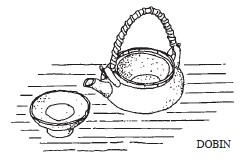
dengaku でんがく 田楽 preparation in which food such as eggplant, taro, konnyaku, and tofu are dressed with a sweetened miso topping and grilled on skewers. Fish dengaku is called gyoden.
denpun でんぷん 澱粉 starch (C6H10O5). It is used in the making of kamaboko and in some preparations of mizuame, nori, and saké.
dobin どびん 土瓶 teapot. Made of pottery or china, it has a semicircular bamboo handle over the top.
dobinmushi どびんむし 土瓶蒸し delicate clear soup made in an individual miniature dobin. It is a famous autumn speciality of Kyoto and usually contains matsutake, chicken, mitsuba, and ginnan. The juice of sudachi is squeezed into the dashi, which is drunk from little cups. The other ingredients are fished out with chopsticks and eaten. One of the great delicacies of Japan.
doburoku どぶろく 濁醪、 濁酒 See Appendix 7.
dojō どじょう 泥鰌 loach Misgurnus anguillicaudatus. A freshwater fish that used to proliferate in rice paddies before the extensive use of agricultural chemicals. Since the whole fish is eaten, it is a good source of calcium. It is usually eaten as an accompaniment to shōchū or saké. Not highly rated.

donabe どなべ 土鍋 earthenware pot, shaped like a large bowl, much used for nabemono. Usually its lid has a hole in it and it is glazed inside but not out. For cooking, it is placed directly on top of a konro or shichirin.
donburi どんぶり 丼 1. pottery or china bowl, two or three times the size of a rice bowl, often with a lid. 2. the food served in such a bowl, consisting of rice with various ingredients placed on top. Among the favorites are oyako donburi, in which chicken and egg are used, tendon with tempura, gyūdon with beef, katsudon with tonkatsu, and unadon with eel. These dishes provide a simple, popular meal in a bowl.
dotenabe どてなべ 土手鍋 nabemono in which the stock is richly flavored with miso. The usual ingredients are oysters and yakidōfu, with shirataki and a variety of fresh vegetables.
ebi えび 海老、 蝦 prawn, shrimp Penaeidae spp. The word ebi covers a wide range, including crawfish (ise ebi), but unqualified, it usually refers to prawns or shrimps, of which there are many varieties. The amaebi is a sweet-tasting prawn about 12 cm in length particularly used for sushi. The kuruma ebi is larger, at up to 20 cm, and is used for sushi even more than amaebi. It is also used for sashimi and agemono, the best example of which, deservedly very popular, is ebi furai, in which these succulent large prawns are coated with egg and bread crumbs and deep-fried. For tempura, the popular prawn is saimaki ebi, about 7 to 10 cm long, but also the larger shiba ebi, 10 to 15 cm, is extensively used. Shiba ebi is particularly tasty and is also used in sushi, sunomono, and kakiage. The botan ebi grows to 14 cm and is in season from October to May. It can be eaten raw and is also prepared as tempura and furai. The hokkai ebi, about 13 cm long, is prolific off the northern shores of Hokkaido. It can be prepared as tsukudani, though much of the catch is peeled and canned. The giant among the prawns is the taishō ebi, 27 cm long. A kind of kuruma ebi, its true name is kōrai (Korean) ebi. It is used for tempura and furai and is good sautéed with vegetables. At the other end of the scale, the sakura ebi is a pretty little shrimp of 5 cm, a light red color and highly luminescent. It can be eaten as is, but is usually dried, either in the sun or with applied heat. It is used to provide a colorful touch.
edamame えだまめ 枝豆 pod soybean Glycine max. In summer, pods of young soybeans (daizu) on the stalk are boiled and the beans eaten as a side dish with beer. Also called sayamame.
edomaezushi えどまえずし 江戸前鮨 See Appendix 11.
egoma えごま 荏胡麻 perilla Perilla frutescens var. frutescens. The leaves are used in the same ways as those of shiso, and the seeds, when parched, smell just like goma. An edible oil (eno-abura) is also made from the seeds.
ei えい 鱝、 鱏 skate, ray Order Rajiformes. The wings of these large fish, up to 2 m in length, must be eaten very fresh. Skate is cooked as nimono, especially misoni (nimono with miso flavoring) and ei no nikogori 鱝の煮凝り, in which the simmered skate is cooled and jellied. It is also made into amazuankake, a kind of ankake with sweetened vinegar.
ekiben えきべん 駅弁 boxed lunch sold at a railway station. All the major railway stations (eki) throughout Japan have for sale their own special boxed lunch. See also bentō.
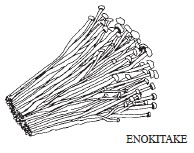
endō えんどう 豌豆 peas Pisum sativum. Green peas, although they have been grown in Japan for a long time, are not greatly used in traditional Japanese cooking. A favorite use is to mix them with mashed potato as a salad.
enokitake えのきたけ 榎茸 winter mushroom Flammulina velutipes. The heads of these tiny white mushrooms on long, thin stalks, growing in clumps, would average about 1 cm. They are very versatile in use, but are mostly eaten in nabemono.
fu ふ 麩 wheat gluten. This ancient product for which Kyoto is renowned comes in two forms. One is raw gluten (nama fu). A dough is made from strong flour (high-gluten flour) and water, and the starch is washed away by kneading under water. The resulting sticky substance is almost completely protein. Usually glutinous rice flour or some other flour is incorporated and coloring as desired. It is then steamed. Nama fu is made into all sorts of decorative shapes and has an important place in shōjin ryōri, being used in clear soups and nimono. The other fu is yaki fu, for which nama fu is grilled or dried in a wide variety of shapes and sizes. It is used in soups, nimono, and sunomono.
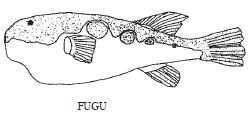
fucha ryōri ふちゃりょうり 普茶料理 vegetarian cuisine of Chinese-style Zen Buddhism. In Japan it is practiced by the Obaku sect of Zen, centered at Manpuku-ji, the great temple at Obaku, near Uji. This vegetarian cuisine is also served at smaller temples and convents in Kyoto and other places. See also Appendix 15.
fugu ふぐ 河豚 puffer, blowfish Family Tetraodontidae. The various kinds of fugu are best known for their poison, and perhaps the main reason for dining at a fugu restaurant is the uncertainty and excitement that this knowledge arouses in anticipation. Certainly the taste of the fish itself is not sufficiently enticing to make one want to take the risk. Tora fugu is considered the best, and can weigh up to 2.5 kg. The restaurant preparation of fugu is very strictly controlled, but domestic preparation, whether of fugu caught on a fishing expedition or bought in a fish market, leads to deaths from time to time. Many, including myself, have survived eating the liver, which is the tastiest and also the most poisonous part, though it has been illegal to serve the liver since 1984. Fugu is served as sashimi and chirinabe, and the fins are toasted and hot saké poured over them. This saké is usually drunk as an aperitif.
fuka ふか 鱶 another word for shark, especially the larger species. The shark’s fin of Chinese cooking is fukanohire ふかの ひれ 鱶の鰭. Most species of shark are called same in Japanese.
fuki ふき 蕗 Japanese butterbur, sweet coltsfoot Petasites japonicus. Looking like giant rhubarb, the 1.2-m-long stems of this vegetable have a slight flavor of celery. They are blanched and peeled before being fried or made into various pickles. Fuki is also candied. There is a giant variety with 180-cm-tall stalks.
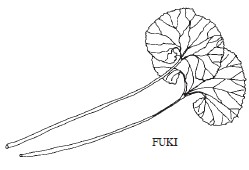
fukinotō ふきのとう 蕗の薹 unopened bud of Japanese butterbur. Available only in early spring, the buds are blanched to remove some of the bitterness and are used in miso shiru, tempura, tsukudani, and nabemono.
fukujinzuke ふくじんづけ 福神漬け one of the most popular pickles and an invariable accompaniment of Japanese-style curry and rice. A mixture of seven vegetables thinly sliced is salted and then pickled in soy sauce and mirin. The seven vegetables are chosen from among white radish, eggplant, lotus root, ginger, shiso buds, turnip, shiitake, udo, sword beans, shirouri, and others.
funa ふな 鮒 wild goldfish Carassius auratus. A freshwater fish mainly found in lakes such as Lake Biwa near Kyoto, famous for its funa called nigoro buna (C. auratus grandoculis), which is made into funazushi, an ancient form of sushi. Funa lives for ten to fifteen years, reaches a length of 40cm, and is at its best in winter. It is used for narezushi, sashimi, sunomono, tsukudani, and in soups. See also narezushi.
furai フライ a very popular method of cooking in which prawns, fillets of fish, or slices of meat are dipped in egg, coated with panko, and deep-fried. Ebi (prawn) furai is a particularly successful dish.
furikake ふりかけ 振り掛け topping sprinkled on hot rice. Usually it contains toasted seaweed and sesame seeds as well as ground dried fish and salt.
furofuki ふろふき 風呂吹き winter dish in which well-boiled white radish or turnip is served with a topping of miso flavored with yuzu or sesame. The classic dish is made with daikon.
ganmodoki がんもどき 雁擬き tofu product. Tofu is mixed with crushed yamanoimo and chopped vegetables such as carrot, shiitake, and burdock, as well as sesame seeds, ginkgo nuts, and kelp. This mixture is formed into balls, the size and shape largely depending on local custom, and deep-fried. The balls are used in o-den and nimono.
gari がり thinly sliced ginger macerated in sweetened vinegar. Gari is served as a condiment in sushi shops, and the word is special sushi-shop vocabulary.
gazami がざみ 蝤蛑 blue crab Neptunus trituberculatus. See also watarigani.
genmai げんまい 玄米 brown rice Oryza sativa. Few Japanese eat brown (i.e., unpolished) rice, with the result that it is not easy to get hold of. Best cooked in a pressure cooker, even though the latest rice cookers claim to do the job.
genmai su げんまいす 玄米酢 brown-rice vinegar. An excellent, high-class vinegar, often made by the traditional methods. Best of all is glutinous brown-rice vinegar (genmai mochigome su). Not readily available, it has such an elegant sweetness and smoothness that it can be drunk neat.
geso げそ 下足 squid tentacle, cuttlefish tentacle. Often sold from stalls at festivals as teriyaki, these tentacles are also dried for use as tsumamimono. Geso, a shortened form of gesoku げそく 下足, which means footwear, was originally a sushi-shop word that has spread into common parlance.

gindara ぎんだら 銀鱈 sablefish Anoplopoma fimbria. A kind of cod that grows to almost 1 m in length, this fish comes frozen to Japan from the Bering Sea. It is delicious and can be cooked in numerous ways but spoils quickly and should be cooked and eaten as soon as thawed.
ginnan ぎんなん 銀杏 ginkgo nut Ginkgo biloba. The fruit of this lovely and very primitive tree (ichō in Japanese), though not strictly nuts, do have a shell that must be cracked to get at the kernel. Gathered in September and October, they are yellowish green and about 1.5 cm long out of the shell. Perhaps at their best when skewered and grilled, they are also a regular and welcome ingredient of chawan mushi.
gizami ぎざみ See bera.
gobō ごぼう 牛蒡 great burdock, edible burdock Arctium lappa. It is only in Japan that burdock root is eaten as a vegetable, usually about 1 m long and 3 cm thick. In China it is used as a medicine. The root is a very good source of dietary fiber and nutrients and should be scrubbed rather than peeled, since much of the flavor is close to the skin. For use, it is shaved (like a pencil is sharpened, sasagaki in Japanese) and dipped in cold water with a little vinegar to remove its considerable bitterness, because of which it is unsuitable for nabemono. Burdock is combined with carrot to make kinpira gobō and is used in kakiage and numerous other dishes.
gogyō ごぎょう 御形 cudweed Gnaphalium affine. Better known as hahakogusa ははこぐさ 母子草. See also nanakusagayu.
gohan ごはん 御飯 cooked rice. As with the informal word meshi, it can also refer to a meal.
goma ごま 胡麻 sesame Sesamum indicum. A nutty-flavored, oil-rich little seed of which three forms are marketed: black, white, and golden. Golden sesame has the best aroma but is not so readily available. Sesame is always parched before being used in such things as in furikake, aemono, and goma dōfu. Sesame oil is used in cooking, particularly for its flavor, and is important in the oil mixture for tempura.
goma dōfu ごまどうふ 胡麻豆腐 sesame tofu. Rather like a firm, baked, savory custard only gray, this resembles tofu only in texture and presentation. White sesame, usually parched, is pulverized with water, and the liquid is strained. This liquid is thickened with kuzu and set in a square shape. Served with wasabi, it can be highly recommended. Sesame tofu has an important place in all schools of Buddhist vegetarianism, such as shōjin ryōri and fucha ryōri.
goma shio ごましお 胡麻塩 sesame salt. Sesame and salt are slightly or well ground and combined into a condiment for use at table. Any kind of parched sesame may be used. It has a particularly important place in macrobiotics, no doubt because brown rice is scarcely edible without some salt at least.
gomoku meshi ごもくめし 五目飯 rice dish in which small pieces of chicken, tofu, and various vegetables in season are flavored with soy sauce and cooked with the rice. Shiitake, carrot, burdock, konnyaku, and abura-age are often used.
gomokuzushi ごもくずし 五目鮨、 五目寿司 See Appendix 11.
gyokairui ぎょかいるい 魚介類 seafood; fish and shellfish.
gyokuro ぎょくろ 玉露 highest-quality green tea. See also Appendix 12.
gyoshō ぎょしよう 魚醤 See uoshōyu.
gyōza ギョーザ 餃子 a kind of Chinese dumpling (dim sum). A filling, usually of pork, cabbage, and nira minced to a fine paste, is used to fill circles of thin flour pastry shells with a scalloped join at the top. They are steam-fried or deep-fried or may be boiled in soup or nabemono. They are extremely popular and are often served at home as part of a regular Japanese meal.
gyūdon ぎゅうどん 牛丼 donburi dish featuring slices of beef.
gyū niku ぎゅうにく 牛肉 beef Bos taurus. After a long period in which the eating of beef was unthinkable, Emperor Meiji did his best to get the Japanese to eat beef, issuing a statement of approval in 1873. Gyūnabe, now called sukiyaki, had already appeared in the 1850s. Shabu shabu has also become a popular way of eating beef, as has yakiniku. Most of the Western ways of eating beef are also popular.
hachimitsu はちみつ 蜂蜜 honey. It is sometimes used to sweeten such things as umeshu but has little place in Japanese cuisine.
hadakamugi はだかむぎ 裸麦 naked barley, a variety of Hordeum vulgare. A species of barley particularly grown in western Japan. The grains closely resemble those of wheat.
hage はげ See kawahagi.
hajikami はじかみ 薑、 椒 See shōga.
hakkō はっこう 発酵、 醗酵 fermentation. The making of such products as saké, shiokara, and nattō involves a process of fermentation.
hakobe, hakobera はこべ、 はこべら 繁縷 chickweed Stellaria media. See also nanakusagayu.
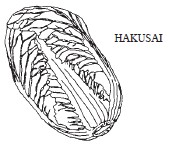
hakumai はくまい 白米 white (polished, or rather, milled) rice Oryza sativa. The short-grained subspecies japonica is the staple food of the Japanese. Milling reduces the grain to 90 to 92% of its unmilled size. The rice polishings (nuka) are used as a pickling base for a type of pickle called nukazuke. The normal cooking method is to steam-boil the rice in a tightly closed pot containing just the amount of water that will be absorbed by the time the rice is cooked. Automatic rice cookers remove all doubts and guesswork, the latest models being programmed with “neuro” and “fuzzy” chips, but they do not produce the crisp outer crust (o-koge 御焦げ), which is a great treat.
hakusai はくさい 白菜 Chinese cabbage Brassica campestris var. amplexicaulis. From autumn to spring, this large cabbage is used in all kinds of dishes, but especially in nabemono and tsukemono.
hama bōfu はまぼうふう 浜防風 Glehnia littoralis. A plant of the same family as seri, with a similar appearance except that it has red stems, it grows in the sands by the seashore. In spring the young shoots are eaten raw with sashimi and as a garnish for sunomono of fish. For summer use in aemono it is blanched both to remove the bitterness and to cook it.
hamachi はまち See inada.
hamaguri はまぐり 蛤、 文蛤、 蚌 Venus clam, hard clam Meretrix lusoria. These clams, about 8.5 cm long, 4 cm wide, and 6.5 cm high, gathered from the foreshores throughout Japan, are at their best from winter to spring. In the shell, they are served in suimono, barbecued, or steamed with saké. The flesh is used for sushi and clam rice and can be grilled on skewers.
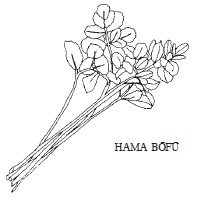
hamo はも 鱧 pike conger Muraenesox cinereus. This sharp-toothed, 2-m-long eel comes mostly from the warm waters off central and western Japan, especially the Inland Sea. Its small bones are so prolific that a special knife (hamokiri bōchō) is used to bone it. At its best in summer, it is served as kabayaki, teriyaki, tempura, the special kind of pressed sushi called oshizushi, and sunomono.
hanami はなみ 花見 cherry-blossom viewing. Since ancient times the Japanese have taken great delight in the fleeting blossoms of the cherry tree. On Japan’s four main islands, the trees bloom first in Kyushu, from the middle of March, and the blossoming follows the progress of spring, finally reaching the northernmost parts of the country in May. Parties are held day and night under the flowering trees, picnic foods are eaten, a lot of saké, beer, and other alcohol is drunk, and there is much singing, revelry, and enjoyment.
hanasakigani はなさきがに 花咲蟹 hanasaki crab, blue king crab Paralithodes brevipes. Similar to but smaller than the tara-bagani, this delicious crab is prolific in the waters off the Nemuro Peninsula of northeastern Hokkaido. See also kani.
hangō はんごう 飯盒 outdoor rice cooker. A container, usually made of aluminum, in which sufficient rice for one or two people can be carried with the water necessary for cooking it. The rice and water are combined and the hangō is set over a fire until all the water is absorbed and the rice is ready.
hanpen はんぺん 半片 fish-paste cake. Whitefish such as shark is made into a paste with yamanoimo, spread into molds, and boiled till set. It can be eaten as it is with ginger-flavored soy sauce, but is most commonly served in o-den.
harusame はるさめ 春雨 “spring rain” noodles. The best quality, from China, are made from mung-bean starch. The Japanese ones are made from potato starch or sweet-potato starch. They are transparent, less than 1 mm thick, and from 20 to 30 cm long. As well as being used in nabemono and sunomono, they can be deep-fried, puffing up and becoming white.
hashi はし 箸 chopsticks. See also Appendix 1.
hassaku はっさく 八朔 hassaku orange Citrus hassaku. A very firm-fleshed, non-juicy, orange-type citrus fruit mostly grown in Wakayama, Ehime, and Hiroshima prefectures, where it originated. In season from December to April.
hasu はす 蓮、 藕 lotus. See also renkon.
hasunomi はすのみ 蓮の実 lotus seed. In autumn these seeds can be eaten raw, having a mild sweetness, but usually they are preserved by boiling and drying. A paste made from lotus seeds is used as a filling for wagashi.
hata はた 羽太 grouper Epinephelus septemfasciatus (ma-hata). Reaching up to 90 cm in length, ma-hata is eaten from midsummer to early autumn as sashimi, shioyaki, and nitsuke. The much smaller kijihata, at around 40 cm, is particularly tasty.
hatahata はたはた 鰰、 燭魚 sandfish Arctoscopus japonicus. A northern sea fish of about 15 to 25 cm in length, it is especially plentiful around Akita and Yamagata prefectures. It is a fairly fatty, white-fleshed fish and is eaten as tempura, sushi, shioyaki, and nitsuke. It is also dried, preserved as shiokara, and used as the basis for Akita’s well-known shottsuru.
hatchō miso はっちょうみそ 八丁味噌 100% soybean miso. See also Appendix 6.
hatomugi はとむぎ 鳩麦 adlay Coix lachryma-jobi var. mayuen. A variety of Job’s-tears, consumed for its nutritional qualities rather than its flavor, which is disappointing. Its flour can be mixed with wheat flour for whatever use, and the grains are parched, decocted, and made into a drink with boiling water.
hattai[ko] はったい[こ] 糗粉、 麨粉 See ōmugi.
haze はぜ 沙魚、 鯊 goby, gudgeon Acanthogobius flavimanus (ma-haze). The goby is widespread and exists in many species, but the well-known one of Tokyo Bay is the ma-haze, which grows to 20 cm or so. Its soft flesh is highly regarded and particularly good as tempura. For sashimi it is sliced into thin strips. It is also preserved as kanroni.
hechima へちま 糸瓜、 天糸瓜 sponge gourd, loofah, luffa Luffa cylindrica. This plant grows in the south or Kyushu, and the young gourds are eaten in many ways, such as sunomono and aemono. It can also be briefly blanched and served with sumiso.
hie ひえ 稗 Japanese barnyard millet Echinochloa utilis. Formerly a staple of the Japanese diet, it is little eaten today. However, it is sometimes mixed with white rice, and can be made into kayu and dango.
higashi ひがし 干菓子 dry confectionary. One category of wagashi, higashi is any kind of dry candy such as toffee, and also includes senbei. In any case, the water content must be less than 20%. Most commonly, however, the word refers specifically to the little dry confections used in the tea ceremony. They are made from rice flour and sugar, which is colored and pressed into small, decorative molds. The best confections are made with wasanbon. Kyoto is particularly famous for its higashi.
hijiki ひじき 鹿尾菜、 羊栖米 hijiki Hizikia fusiforme. A particularly nutritious seaweed that becomes a rich black when boiled before drying. Hijiki mame is an excellent and very popular dish, very rich in minerals and protein, in which soybeans and hijiki, both soaked, are sautéed in oil and seasoned with soy sauce and sugar.
hikiniku ひきにく 挽き肉 ground meat, minced meat, mince. Japanese butchers normally sell a variety of minced meats such as beef, pork, and chicken. Minced meat is used in tsukune, soboro, gyōza, and the cabbage rolls that are often found in o-den.
himono ひもの 干物 dried fish. Sun, wind, and dry night air are all used to dry a variety of lightly salted fish. Before drying they can be grilled or seasoned with mirin. The best way to eat them is hot from the grill.
hina matsuri ひなまつり 雛祭 festival for girls held on March 3. Also called the doll festival because of the display of dolls set up in houses where there is a girl. Traditional foods include diamond-shaped rice cakes called hishimochi colored white, pink, and green, as well as shirozake, a white-colored drink made from glutinous rice, rice mold, and mirin.
hirame ひらめ 平目、 鮃、 比目魚 bastard halibut, false halibut Paralichthys olivaceus. At its best from September to February, this is a highly regarded fish that can be prepared in every way. Since it sometimes harbors nematode parasites, it is safer cooked rather than eaten as sashimi or sushi.
hiratake ひらたけ 平茸 oyster mushroom Pleurotus ostreatus. This mushroom, gray-capped and white-fleshed, 5 to 15 cm across the cap, is delicious when gathered from the wild from spring till autumn. The less delicious cultivated version is usually marketed under the name of shimeji.
hiroshima na ひろしまな 広島菜 a variety of Brassica campestris var. chinensis. This green-leaved vegetable is cultivated almost exclusively for making Hiroshima’s famous salt pickle.
hishinomi ひしのみ 菱の実 water chestnut, water caltrop Trapa bispinosa var. iinumai. Young ones are eaten raw; harder, more mature ones are boiled, grilled, and then eaten. They are rather like chestnuts to eat but are not used in cooking.
hishio ひしお 醤 Historically hishio has a very important place in Japan’s food culture. There were originally three types: 草醤 kusa bishio, equivalent to today’s tsukemono; 肉醤 shishi bishio, equivalent to shiokara; and 榖醤 koku bishio, fermented grain products such as miso and soy sauce. It is from the latter that modern hishio, popular in western Japan, has developed. Vegetables such as eggplant, ginger, and shirouri, with hulled, split soybeans, are fermented in a kind of barley miso. It is a high-class product of limited availability. See also morokyū.
hiyamugi ひやむぎ 冷麦 dried noodle made of wheat, in thickness coming between sōmen and udon. After boiling, the noodles are chilled and served with a fairly chili-hot dipping broth. A summer dish.
hiyashi ひやし... 冷し... cold. Generally prefixed to the names of foods normally expected to be hot, e.g., hiyashi sōmen.
hiyayakko ひややっこ 冷奴 cold tofu. A simple dish in which a block of cold tofu is eaten with finely sliced welsh onion, grated ginger, kezuribushi, and soy sauce.
hōbō ほうぼう 魴鮄、 竹麦魚 bluefin gurnard, bluefin sea-robin Chelidonichthys spinosus. A highly regarded, white-fleshed fish about 40 cm long, at its best in winter. It is used in soups and nabemono and is also good as shioyaki and agemono.
hōchō ほうちょう 包丁 Japanese cook’s knife. Apart from the fact that they cut, these knives are in a different world from anything known in Western culture. Like swords, they are forged and are sharpened on one side of the blade only, allowing extremely clean, accurate slicing. They must be sharpened on several different whetstones, a knife steel being totally unsuitable. The three main types are sashimi bōchō; deba bōchō, for dealing with fish, apart from sashimi; and usuba bōchō, for fine work with vegetables. A good cutler might sell over fifty different kinds of knives made from traditionally forged steel.
hōjicha ほうじちゃ 培じ茶 parched bancha. See also cha and Appendix 12.
hojiso ほじそ 穂紫蘇 stem (spike) of young budding shiso. The little buds are scraped off to be used as a condiment. Pickled hojiso is served with shiruko.
hokkai ebi ほっかいえび 北海海老 Hokkai shrimp Pandalus kessleri. About 13 cm long, this shrimp is prolific off the northern shores of Hokkaido. It can be prepared as tsukudani, though much of the catch is peeled and canned.
hokke ほっけ  Atka mackerel Pleurogrammus azonus. Caught in large quantity in the northern waters from the beginning of winter to the following spring, this fish is about 40 cm long. Very good when quite fresh, it does not keep well because of its high fat content. It is usually grilled or simmered as nimono.
Atka mackerel Pleurogrammus azonus. Caught in large quantity in the northern waters from the beginning of winter to the following spring, this fish is about 40 cm long. Very good when quite fresh, it does not keep well because of its high fat content. It is usually grilled or simmered as nimono.
hokki gai ほっきがい 北寄貝 surf clam, hen clam Spisula sachalinensis. This clam, which is also called ubagai, is about 9.5 cm long, 4.5 cm wide, and 7.5 cm high and is most prolific in the Sanriku and Hokkaido areas. The flesh has an off-white color but turns pink when boiled. At its best from spring to summer, it is served as sashimi, sushi, yakimono, sunomono, and in suimono.
hone nuki ほねぬき 骨抜き tweezers for removing fish bones.
honshimeji ほんしめじ 本湿地 honshimeji Lyophyllum shimeji. An autumn mushroom of excellent flavor, it is difficult to cultivate and what is widely sold as (cultivated) honshimeji is actually buna shimeji (Hypsizigus marmoreus). Shimeji is used in soups, tempura, and nitsuke. According to one saying, matsutake is for aroma, shimeji for flavor.
honzen ryōri ほんぜんりょうり 本膳料理 The zen of the name refers to the short-legged trays on which this formal style of food is served. It is one of the three basic styles of traditional cooking, the other two being kaiseki ryōri 1 and 2, both of which are at present more frequently served than honzen ryōri. The menu has a highly formalized structure based on ichijū sansai, which can be extended to two soups and five or seven side dishes, or three soups and eleven side dishes, which should emphasize variety of flavor. This formal style of cooking is for the most part found only at weddings and funerals.
horagai ほらがぃ 法螺貝、 吹螺、 梭尾螺 trumpet shell Charonia tritonis. The flesh from this large shell, up to 40 cm long and 19 cm in diameter, is eaten raw as sashimi, sunomono, and aemono. It is also baked in the shell as tsuboyaki.
hōrensō ほうれんそう 法蓮草、 菠薐草 spinach Spinacia oleracea. A favorite vegetable in Japan, it is a frequent ingredient of soups, but is at its best in the cooked salad hōrensō no goma ae. It also makes excellent o-hitashi.
hōroku ほうろく 焙烙 round earthenware platter. Used for parching seeds and grains as well as tea and salt, it usually has a domed lid so that it can be used for steam-baking (hōroku-yaki). In this style of cooking, the ingredients are usually set on a bed of pine needles and are cooked and served in the hōroku.
horumon ryōri ホルモンりょうり ホルモン料理 offal, variety meats. This kind of cooking originated among Korean residents of Japan. The name “hormone” derives from the fact that many of these organs are glands. Pork, beef, and chicken organs are used. They are either grilled as yakiniku or yakitori, or are used in the one-pot dish called motsunabe. As well as heart, liver, and gizzard, tripe is extensively used.
hotategai ほたてがい 帆立貝 scallop Patinopecten yessoensis. A large bivalve, up to 20 cm across, it is prolific in the waters of northern Honshu and Hokkaido and is extensively farmed. It is especially prized for its tender adductor muscle (kaibashira), which makes delicious sashimi. In cooking, the female (red) roe and male (cream) roe, and often the mantle, are usually left attached to the muscle. Scallops are served in soups, nimono, yakimono, and agemono.
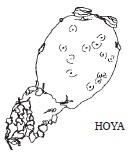
hotokenoza ほとけのざ 仏の座 henbit Lamium amplexicaule. See also nanakusagayu.
hoya ほや 海鞘、 老海鼠 sea squirt Class Ascidiacea, especially doroboya (Corella japonica) and eboya (Styela clava). Somewhat limited in appeal, these creatures are present in all the waters surrounding Japan, but are particularly prolific in the coastal areas of Sanriku and north of Akita. Their best season is July and August. They are eaten raw after being skinned and their intestines are served in sunomono. Fermented sea-squirt intestines are a kind of shiokara similar to konowata.
ichigo いちご 苺 strawberry Fragaria x ananassa. A very popular fruit frequently served with condensed milk rather than cream at the end of a meal. Strawberry jam is also very popular. The winter availability of empty rice fields and the unsuitability of Japan’s humid rainy season and hot summer have led to the practice of growing strawberries in vinyl houses on the empty fields in winter and spring. Donner, harunoka, toyonoka, fukuba, nyohō, and hōkōwase are widely grown varieties.
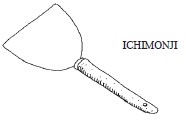
ichijiku イチジク 無花果、 映日果 fig Ficus carica. Introduced into Japan in the early seventeenth century, the fig has a restricted place among the autumn dessert fruits.
ichijū sansai いちじゅうさんさい 一汁三菜 one soup, three vegetables. This combination is the basis on which Japanese menus are constructed. Apart from rice, there should be soup and at least three dishes containing vegetables, customarily from the categories of namasu, nimono, and yakimono.
ichimi tōgarashi いちみとうがらし 一味唐辛子 ground chili pepper. See also shichimi tōgarashi.
ichimonji いちもんじ 一文字 scraper-spatula. The handle of this utensil is vertical to the blade, which makes it particularly useful in cooking o-konomiyaki.
ichiyazuke いちやづけ 一夜漬け See tsukemono.
igai いがい 貽貝 mussel Mytilus coruscus. As often as not, mussels are called mūrugai ムール貝, from the French moule, meaning mussel. At their best when steam-baked as hōroku-yaki, they are also good boiled, baked, and as sunomono. Their season is from January to March. A similar but rather larger mussel is the karasugai, which, though edible, has a muddy smell. In some parts of Japan igai is called karasugai.
iidako いいだこ 飯蛸 See tako.
ika いか 烏賊 squid: various dibranchiate cephalopods. Squid are a popular everyday food throughout Japan. They can be anything from bite-size to 50 cm long and are a cheap source of good protein, very low in fat. Above all served as sushi and sashimi, squid is also served as tempura and grilled, especially as teriyaki. Dried squid (surume) is a favorite snack with drinks.
ikanago いかなご 玉筋魚 Pacific sandlance Ammodytes personatus. Best when it is five to six months old and about 10 cm long. It is boiled in salt water and cooled, then served in vinegar-flavored soy sauce or sumiso. It is also made into tempura, tsukudani, and dried.
ikanago shōyu いかなごしょうゆ 玉筋魚醤油 See uoshōyu.
ikizukuri いきづくり 生き作り、 活き造り See sashimi.
ikura イクラ salmon eggs. Though hardly to be compared with caviar, these shiny red eggs are considered a luxury and are very good as a topping for sushi. The word ikura is derived from the Russian word ikra, meaning fish eggs. For salmon roe in the piece, see also sujiko.
imo いも 芋、 藷、 薯 potato. Japan has a wide range of potatoes, including yams, sweet potato, and taro. See also jagaimo, yamanoimo, satsumaimo, and satoimo.
inada いなこ 鰍 yellowtail, Japanese amberjack Seriola quinqueradiata. Called hamachi in western Japan and increasingly so in other parts of the country, this is the young of buri, about 40 cm long. It is preferable to buri for sushi and sashimi and is very good grilled as shioyaki. Best in summer.
inarizushi いなりずし 稲荷鮨、 いなり寿司 See Appendix 11.
ingenmame いんげんまめ 隠元豆 kidney bean Phaseolus vulgaris. The mature beans are mostly dried and then prepared as nimono, an, or amanattō, a kind of wagashi. For the young bean, see also sayaingen.
inobuta いのぶた 猪豚 boar-pig cross. The flesh of this creature has the best of both worlds: the tenderness of pork and the lean gaminess of wild boar. It makes an excellent nabemono.
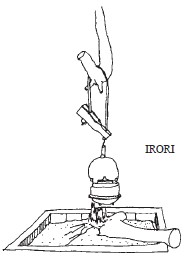
inoshishi いのしし 猪 wild boar Sus scrofa. Boars are still reasonably prevalent in Honshu, Shikoku, and Kyushu. The best wild boar comes from the young animals in winter. Wild boar is also referred to as yama kujira (mountain whale) and botan (peony) and is not always wild. See also botan nabe.
ippin ryōri いっぴんりょうり 一品料理 a la carte. On a menu, this most frequently indicates dishes ordered separately to be eaten with drinks.
irigoma いりごま 煎り胡麻、 炒り胡麻 parched sesame. Sesame seeds are normally parched before use, a task that requires skill and attention to avoid overcooking.
iriko いりこ 煎り子、 炒り子 small dried fish used for making dashi.
irori いろり 囲炉裏、 炉 central hearth. The hearth was formerly a feature of Japanese houses in mountainous areas, and many still exist, especially in country restaurants, for nostalgic effect. Part of the dining-kitchen area of a house, the hearth was adjacent to the doma, the beaten-earth floor area for food preparation at the lower, ground level. Although some cooking was done at the irori, its main purposes were heating and drying. See also o-yaki, kiritanpo, and Appendix 3.
isaki いさき 伊佐木、 伊佐幾 grunt Parapristipoma trilineatum. Found in the warmer western waters, this fish grows up to 40 cm in length. Best in summer, it makes good sashimi when very fresh. Otherwise, it is cooked as shioyaki or furai.
ise ebi いせえび 伊勢海老 crawfish, Japanese spiny lobster Panulirus japonicus. This crustacean can reach 35 cm, though is usually smaller, not least because the Japanese waters are becoming seriously depleted. It makes excellent but rather expensive sashimi, and is very good split in half and grilled.
ishikarinabe いしかりなべ 石狩鍋 salmon hodgepodge. A famous nabemono of Hokkaido. Salmon, with both hard and soft roe, is cooked in a large pot of dashi with miso and various vegetables, tofu, and konnyaku. The diner adds a sprinkling of sanshō powder at the time of eating.
ishiyaki いしやき 石焼き baking on hot stones, in one of two different contexts. In the first, chestnuts and sweet potatoes are cooked in hot pebbles by street vendors, often itinerant. The second setting is a high-class restaurant (ryōtei), where a hot stone, slices of abalone (and other things), and a dipping sauce are placed in front of the diner. The food is cooked on the stone, dipped, and eaten immediately.
ishiyaki imo いしやきいも 石焼き芋 baked sweet potato. Itinerant vendors bake sweet potatoes in hot pebbles and sell them at all hours of day and night. They are very popular with children after school and adults returning home late from work or drinking. The vendor is announced by a steam whistle or traditional cry.
isobe いそべ 磯辺 prefix for dishes prepared or garnished with nori. A typical example is hōrensō no isobemaki, in which spinach leaves that have been lightly boiled are served rolled up in nori.
itadori いたどり 虎杖 Japanese knotweed, flowering bamboo Polygonum cuspidatum. Found in the mountains in spring, when the shoots are 20 to 25 cm long. The shoots are peeled and eaten raw with salt, and have a slightly acidic taste. Itadori is also used in nimono. See also sansai, sansai ryōri, and Appendix 9.
itamae いたまえ 板前 chef (for Japanese cooking). Whereas chōrishi refers to qualifications, itamae refers to the cook’s position at the head of the kitchen team. The word itamae literally means in front of the chopping board.
itamemono いためもの 炒め物 shallow-fried dish. The Japanese equivalent of Chinese stir-frying. A flat-bottomed frying pan is used with very little oil.
itawasa いたわさ 板山葵 sliced kamaboko served with wasabi and soy sauce.
itayagai いたやがい 板屋貝 bay scallop Pecten albicans (syn. Pecten laquetus). Similar in all important respects to hotategai only much smaller (up to 12 cm across). Found along all the coasts of Japan except northern Hokkaido. Itayagai is more or less the same as the St. James shell, coquille Saint-Jacques (Pecten jacobaeus). See also hotategai for culinary uses.
iwana いわな 岩魚 char Salvelinus leucomaenis. Lives in cold mountain streams and grows to a length of about 30 cm. At its best from May until summer, it is cooked in the same ways as other trout. See also kawamasu.
iwanori いわのり 岩海苔 See nori.
iwashi いわし 鰯、 鰮 sardine, pilchard Sardinops melanostictus (ma-iwashi). An abundant fish in quantity, species, and local names, the smaller ones (less than 10 cm) are at their best in June, whereas the larger ones are better from August to October. They make very good, cheap sashimi, and in some places itinerant street vendors fillet them in front of customers’ houses. They can be made into tempura and dango and have many other uses.
iwatake いわたけ 岩茸、 石茸 Umbilicaria esculenta. A lichen that is collected at great danger from cliff faces, it is considered a great and rather expensive delicacy. Iwatake lives on the cliff faces for a century or more and is gathered by rappelling (abseiling) collectors. It is thoroughly washed to remove the dust that has collected over the years, soaked for two days, then made into tempura or sunomono. It is mostly harvested in Shikoku, but formerly in many other parts of Japan as well. Very limited in appeal, it is nevertheless considered a great luxury, probably for reasons other than its flavor.
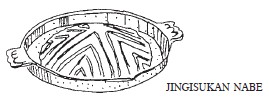
iyokan いよかん 伊予柑 Iyo orange Citrus iyo. Although this delicious orange is named after a former province in Shikoku, it was developed in Yamaguchi in 1886. As well as being eaten fresh, it is much used in marmalade making.
izakaya いざかや 居酒屋 simple tavern, where customers eat and drink at small expense in a cheerful atmosphere.
jagaimo じゃがいも じゃが芋、 馬鈴薯 potato Solanum tuberosum. Many varieties are grown in Japan, one of the most popular being May Queen メークイーン. The potato is particularly associated with Hokkaido, where it is grown extensively. It goes well in nimono, o-den, and soups, and is much used in Western-style cooking. Potato starch has many uses, having all but replaced true katakuriko. Potato is also called bareisho.
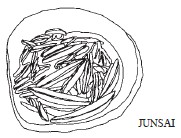
jinenjo じねんじょ 自然薯 See yamanoimo.
jingisukan nabe ジンギスカンなべ 成吉思汗鍋 Genghis Khan hot plate. For this dish, which comes from Mongolia, mutton and vegetables are cooked on a domed, shield-shaped hot plate, which is ribbed and often has holes in it. The grilled food is dipped in a sauce strongly flavored with garlic and eaten. It is a kind of yakiniku.
jizake じざけ 地酒 local saké. A saké of small production, for the most part drunk where it is produced. Many such sakés are excellent and are sometimes available beyond their locality or can be obtained by delivery service.
jōshinko じょうしんこ 上糝粉 See shinko 2.
jūbako じゅうばこ 重箱 tiered food box. Usually in three layers, these boxes are lacquered and can be great works of art. They are used at New Year and other festive times to house special foods. See also jūzume and o-sechi ryōri.
junsai じゅんさい 蓴菜 water shield Brasenia schreberi. A little water plant growing in ponds and marshes that has long, threadlike stems thrown up from the root. In spring and early summer these produce leafy shoots enclosed in a gelatinous sheath, which float on the surface and are gathered from small boats. It is an expensive delicacy with virtually no flavor, appreciated for its gelatinous texture. Often served in suimono, it is almost impossible to retrieve with chopsticks. It is also prepared as aemono and is eaten with soy sauce and wasabi, and also with sanbaizu. It is sold loose (in plastic bags) and in bottles.
jūzume じゅうづめ 重詰め food arranged in a jūbako. The box can have up to five tiers, and there are traditional rules for arranging the food.
kabayaki かばやき 蒲焼 one kind of yakimono, in which the fish is opened up, boned, and skewered, then grilled while being basted with a thick, sweet sauce. Eel kabayaki (unaginokabayaki) is justifiably the best-known dish of this kind. Served on a bowl of hot rice, it is one of Japan’s great treats.
kabocha かぼちゃ 南瓜 pumpkin, winter squash Cucurbita moschata. The Japanese pumpkin, though fairly small, makes very good tempura and is also served as aemono. When simmered as nimono or steamed as mushimono, the skin becomes tender enough to eat. Kikuza and bizen chirimen are popular varieties.
kabosu かぼす Citrus sphaerocarpa. A juicy, green citrus fruit with the sharpness of lemon, it is used instead of vinegar to make sunomono and ponzu for nabemono. Its largest crop is in September and October.
kabu かぶ 蕪、 蕪菁 turnip Brassica campestris var. glabra. One of Japan’s old vegetables, formerly called suzuna. Harvested in autumn and winter, it comes in all sizes and several colors. Red akakabu should not be confused with beetroot, since they are only superficially similar. Kabu and maru daikon (large spherical white radish) are also easily confused. The famous Kyoto pickle senmaizuke is made from the particularly large shōgoin kabu. Mostly the root of kabu is eaten, but some turnips are grown for their leaves. Japanese turnips are tenderer than Western ones, and very white. There are many good recipes for kabu, and many tsukemono are made from turnips. Kabu is also known as kabura かぶら 燕、 蕪菁.
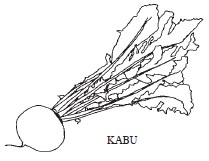
kagami mochi かがみもち 鏡餅 big fat round rice cake in the traditional shape of a mirror (kagami). Two or three of these cakes, of different sizes, one on top of the other, form the basis of the New Year decoration in homes. They are decorated with daidai, konbu, dried persimmons, and other traditional items. On January 11 the cakes are usually cut up and served in zōni or shiruko.
kai かい 貝 (properly kairui かいるい 貝類) mollusk. The expression literally means shell, but since kai does not include prawns, crabs, and lobsters, shellfish is not a satisfactory translation. All kinds of mollusks are great favorites in Japan.
kaibashira かいばしら 貝柱 adductor muscle of bivalve shellfish. The best-known kaibashira is that of the scallop, which is quite large. That of tairagi is also large, but those of bakagai, which has two, are somewhat smaller. They are all versatile, being eaten as sashimi, sushi, tempura, sunomono, suimono, and nabemono.
kaiseki ryōri 1. かいせきりょうり 会席料理 The two kinds of kaiseki have different purposes. This one is for drinking alcohol, whereas 2 is for drinking tea and is frequently called cha kaiseki. Drinking is not conducive to formality and kaiseki ryōri 1, served in a context of singing, clapping, entertainment, revelry, and camaraderie, does not have a formal basis such as honzen ryōri. The simple basis of ichijū sansai is supplemented with a series of dishes to go with drinks (sakana 1), including such things as sashimi, tempura, aemono, and sunomono. When the drinking has stopped, rice, miso shiru, and pickles are served to conclude the party.
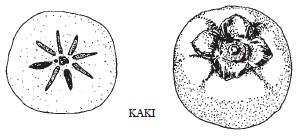
kaiseki ryōri 2. かいせきりょうり 懐石料理 This kind of meal was developed to accompany the tea ceremony, for which see also cha kaiseki and Appendix 13. Cha kaiseki is characterized by formality and restraint, great emphasis being placed on the seasonality of the food and the suitability and beauty of the vessels.
kaisō かいそう 海藻 seaweed. Many different kinds of seaweed, especially nori and konbu, are eaten, forming an important part of the Japanese diet.
kaiware かいわれ 貝割 young shoots (cotyledon) of daikon and kabu. They are extensively used as a salad and garnish, of sushi in particular.
kajiki かじき 梶木、 旗魚 marlin, swordfish Tetrapturus audax (ma-kajiki). The marlins are large fishes. Ma-kajiki grows up to 3 m long and 100 kg in weight. Others are bigger and smaller. In all cases their flesh is like tuna and they are eaten as sashimi.
kaki 1. かき 牡蠣 oyster Crassostrea gigas. Many places in Japan are famous for their oysters, which were first cultivated in Hiroshima in A.D. 1673. They are now cultivated on a very large scale, and as well as being eaten raw, they are served as sugaki, furai, nabemono, and cooked with rice (kakimeshi). Shoopers should be aware of the distinction between oysters for cooking and those for eating raw, especially since oysters are the cause of a lot of hepatitis. Vinegar masks the smell of raw oysters but does not remove the danger of contracting hepatitis from oysters grown in polluted waters.

kaki 2. かき 柿 Japanese persimmon Diospyros kaki. A very popular autumn fruit eaten raw and also made into a very attractive confection dried. Although many of the Japanese varieties of persimmon are sweet (amagaki) and can be eaten raw straight from the tree, many other varieties (shibugaki) have an astringency that must be removed before the fruit can be eaten. Fuyū gaki is a well-known sweet variety, and Saijō, astringent. Dried persimmons form part of the New Year decoration.
kakiage かきあげ 掻き揚げ one kind of tempura. Small fish, shellfish, and shrimps are made into tempura as a clump. Vegetables such as carrot, burdock, and onion are also chopped small and prepared in the same way.
kama かま 釜 rice-cooking pot. A large, deep pot with a flange around the circumference to support it in the hole on top of the kamado. It has a heavy wooden lid with two crosspieces on it to prevent steam from escaping during cooking. It has largely been displaced by the automatic rice cooker.
kamaboko かまばこ 蒲鉾 fish-paste loaf. The flesh of many different kinds of fish both white and dark can be used, but probably shark is most common. A paste (surimi) is made, thickened with starch, sometimes colored pink and green, molded into pillows on a little board, and steamed. It is sliced to serve and may be eaten as is with soy sauce at breakfast or as tsumamimono. It can also be added to o-den. Yakikamaboko (commercially grilled) is also very good, as is agekamaboko.
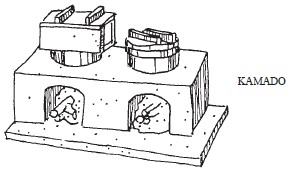
kamado かまど 竈 kitchen range, also called kudo and hettsui. This was built on the beaten earth floor (doma) of the traditional kitchen, but nowadays usually on a concrete floor. The kamado is a kind of enclosed fireplace for a wood fire, with openings in the top for rice-cooking pots (kama) and the pans used for making miso shiru. Each pot has its own fire. The kamado is not used for other cooking, though sometimes a facility for heating water is incorporated, and occasionally it is used in the domestic manufacture of miso. Traditionally there was no flue.
kama meshi かまめし 釜飯 prepared in individual kama, this is a dish of rice cooked with other ingredients, created in the late nineteenth century in Asakusa, Tokyo. Prawns, oysters, scallops, and salmon are used, as well as shiitake mushrooms, bamboo shoots, and chicken. It is sometimes sold as ekiben.
kamasu かます 魳、 梭魚 barracuda, sea pike Sphyraena japonica. Not one of the best eating fish, it is rather watery and is best as shioyaki, kara-age, or furai. Akakamasu, one of the better barracudas, is at its best in summer. It grows to a length of 40 to 50 cm. Some barracudas are poisonous.
kamo かも 鴨 wild duck Anas platyrhynchos. True wild duck is not often available and kamo can be a euphemism for ahiru, domestic duck, or an abbreviation for aigamo, which is what is normally eaten. Aigamo, a cross between wild and domestic duck, is not a game bird, whereas kamo is. Both are used in soups and sukiyaki and grilled and steamed.
kanbutsu かんぶつ 乾物 dried food. A general term for all dried food, though dried fish are called himono.
kani かに 蟹 crab. One of the food delights of winter, of which there are many kinds. See also hanasakigani, kegani, matsubagani, sawagani, tarabagani, watarigani, and zuwaigani.
kani miso かにみそ 蟹味噌 brown cream inside a crab shell. Consisting mostly of the reproductive organs, it is considered a great delicacy (chinmi). It can either be eaten as is straight from the shell of a boiled crab, or further cooked after seasoning with saké, sugar, and egg yolk.
kanmi かんみ 甘味 sweetness. The technical word for sweetness as one of the five basic tastes in the Far East: salty, sour, bitter, sweet, and (in China) pepper hot and (in Japan) tasty. See also Appendix 14.
kanmidokoro かんみどころ 甘味処 traditional teashop. Traditional dessert-like sweets such as mitsumame are served with green tea.
kanpyō かんぴょう 干瓢、 乾瓢 dried gourd strip. Kanpyō is the cream-colored flesh of the white-flowered gourd yūgao, cut into very long thin strips and dried. Its best-known use is as part of the filling for makizushi, but it is also used in soups, aemono, and as an edible tie or string. In shōjin ryōri it is sometimes used to make vegetarian stock. In damp weather it easily goes moldy.
kanroni かんろに 甘露煮 1. a kind of nimono in which various small fish such as ayu, funa, and haze are simmered very slowly in a mixture of soy sauce, mirin, and syrup until they are dry and glistening. 2. the candying of chestnuts, kumquats, and other fruit in unflavored syrup.
kanrozuke かんろづけ 甘露漬け 1. candied preserves. Green Japanese apricots (aoume) and the peel of various citrus fruits such as zabon are candied with sugar. 2. in northern Japan a preserve of kazunoko that is made with soy sauce, saké, and kōji, to be eaten at New Year.
kanten かんてん 寒天 agar-agar Gelidium amansii. A jelly-like substance made from the red alga tengusa. Kanten is eaten with vinegar and soy sauce and is used like gelatin to make jellied dishes. However, it melts at a higher temperature than gelatin, and is therefore more useful in hot weather.
kappa かっぱ 河童 sushi-shop word for cucumber. Lightly pickled cucumber wrapped up in nori seaweed with sushi rice is called kappamaki. Kappa is a mythical monkey-like mischievous creature that lives in ponds and rivers and likes to eat the cucumbers thrown to pacify it.
kappō かっぽう 割烹 1. high-class cookery. 2. high-class Japanese-style restaurant.
kara-age からあげ 唐揚げ、 空揚げ one method of deep-frying. The ingredients are either deep-fried as they are, or more usually dusted with seasoned flour and deep-fried. Kara-age of both chicken and flounder is popular, but vegetables can also be done.
karafuto masu からふとます 樺太鱒 pink salmon Oncorhynchus gorbuscha. This salmon, about 50 cm in length, is mostly canned. It is also a good source of ikura and sujiko.
karashi からし 芥子、 辛子 mustard Brassica nigra; Sinapis alba; Brassica juncea. Japanese mustard is even hotter than English mustard. This is because it is simply a blend of the ground seeds of different mustards without the addition of flour. Mixing with hot water (40°C) and waiting a few minutes brings out the heat. It serves as a condiment for o-den and is used to make tsukemono and dressings.
karashi sumiso からしすみそ 芥子酢味噌、 辛子酢味噌 white miso flavored with mustard and vinegar. Used as a dressing for aemono, especially of fish, it is particularly good with the konnyaku slices called yama fugu.
karasugai からすがい 烏貝 See igai.
karasumi からすみ 鱲子 botargo (dried, salted mullet roe). This is one of the three superlative delicacies (tenka no sandai chinmi 天下の三大珍味), the other two being konowata and uni. The dried roe is eaten as it is, thinly sliced, but may be lightly grilled.
karei かれい 鰈 flatfish, flounder. The eyes on the right (dextral flatfish) are said to distinguish karei from hirame, which has the eyes on the left (sinistral flatfish). The distinction is not valid, however, for there are right-eye karei like ma-garei, Family Pleuronectidae, and left-eye karei like yarigarei, Family Bothidae. Either way, they are delicious, especially as sashimi, yakimono, and agemono. At Onomichi in Hiroshima Prefecture small ones are dried and called debira.
karē ko カレーこ カレー粉 curry powder. It was introduced to Japan from England in the latter part of the nineteenth century and is mostly used for making English-style curry. However, it is sometimes used to flavor the soup for udon and soba.
karin かりん 花梨、 榠樝 Chinese quince Chaenomeles sinensis. The Chinese quince is similar in shape and color to the roughly ovoid Western quince (marumero). However, it has an astringency that must be removed by boiling before use in other ways. An autumn fruit, it is mostly candied or made into jams and jellies.
karintō かりんとう 花林糖 one kind of candy (kakemono-gashi). Pieces of paste made from flour, water, and egg are thoroughly deep-fried and then coated with sugar, usually brown. This candy is said to date from the Heian period (794–1185).
kashi かし 菓子 sweetmeat, confection, “cake.” See also wagashi.
kashiwa かしわ commonly used as a word for chicken meat, strictly speaking, kashiwa refers to the chicken wing. It is considered to have a particularly rich flavor and is very good deep-fried.
kashiwa mochi かしわもち 柏餅 round-shaped mochi filled with an and wrapped in an oak leaf. It is especially eaten on May 5, Children’s Day (formerly Boys’ Day), the symbolism being that oak leaves do not wither.
kasu かす 粕、 糟 saké lees. See also sakekasu.
kasutera カステラ Castella cake. This sponge cake, made of flour, eggs, and sugar, was introduced to Japan by the Portuguese in the sixteenth century. The improvised oven, necessary because the Japanese did not have ovens, gives the cake the texture of a steamed cake. Usually very sweet, it is made by specialist bakers and is often given as a gift.
katakuchi iwashi かたくちいわし 片口鰯 anchovy Engraulis japonicus. This large-mouthed fish grows to a length of 15 cm and is best from September to February. The best way to eat it is raw, straight out of the water, with a dressing of sumiso or ginger-flavored soy sauce. Most of the catch is preserved in various ways, especially by drying.
katakuriko かたくりこ 片栗粉 1. flour of Japanese dog’s tooth violet Erythronium japonicum. This thickening starch is now so expensive that it is used only for top-quality cookery and confectionary. 2. Under the same name, potato starch is now normally used as a cheap substitute.
katsu カツ a kind of agemono of meat, fish, or chicken coated with egg and bread crumbs and deep-fried. The word katsu comes from cutlet, presumably because lamb, veal, and pork cutlets are often cooked in this way. The English word has no reference at all to the method of cooking, being the name of a cut of meat.
katsudon カツどん カツ丼 pork donburi dish. Rice is placed in a large bowl and a slice of pork, fried in egg and bread crumbs, is set on top with onion and sweet stock. A lightly mixed egg is poured over and cooked by the heat of the rice and meat. The dish was thought up by a high school boy in 1923 and today is very popular.
katsuo かつお 鰹 skipjack, oceanic bonito Katsuwonus pelamis. Although this fish reaches a length of 1 m and a weight of between 18 and 25 kg, those caught in the waters off Japan are mostly half that size. They are fished in early summer off southeastern Hokkaido and in autumn in the warmer waters off southern Japan. They are good as teriyaki and sashimi, especially tataki, but a large part of the catch goes into the manufacture of katsuobushi.

katsuobushi かつおぶし 鰹節 dried, smoked, mold-cured bonito. The filleted fish is boiled, dried, smoked, and cured with the mold Aspergillus glaucus. When the fillets are as hard as a piece of wood, they are shaved, and it is the shavings that have numerous uses. Above all, they are used to make soup stock, but are also extensively used as a flavoring and a garnish for such dishes as cold tofu and aemono. See also Appendix 2.
katsuobushibako かつおぶしばこ 鰹節箱 box for shaving katsuobushi. A wood plane is mounted upside down on top of a box to receive the shavings, which collect in a drawer. Using this box was once a normal domestic accomplishment, but nowadays its use is largely restricted to professionals in high-class establishments.
kawahagi かわはぎ 皮剥 leatherjacket, filefish, threadsail fish Stephanolepis cirrhifer. In western Japan known as hage, this is an excellent eating fish that can grow to 30 cm long but is usually taken smaller. At its best in summer, it is very good prepared as nitsuke, the liver particularly so. It is also eaten as sashimi and furai.
kawamasu かわます 川鱒、 河鱒 brook trout, brook char Salvelinus fontinalis. Introduced from North America, this trout is from 20 to 50 cm long and flourishes in the cool river waters of northern Japan. It is at its best from late September to December and is good sautéed or cooked as shioyaki of furai.
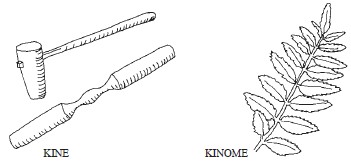
kawano natsudaidai かわのなつだいだい 川野夏橙 See amanatsu.
kayu かゆ 粥 rice porridge. Usually given the honorific o-,i.e., o-kayu, this is primarily a breakfast dish. In the classic version, rice is cooked in much more water than usual and salt and sometimes other things are included. The simplest addition is umeboshi, but salmon, salmon roe, and cod roe are good, with mitsuba, seri, yuzu, kinome, or sanshō as flavoring.
kazunoko かずのこ 数の子、 鯑 prepared herring roe. It may be either salted or dried, but nowadays most kazunoko is salted. To eat, some of the salt is removed by soaking in water. The roe is then dipped in a stock flavored with soy sauce. Kazunoko forms an important part of the New Year menu.
kegani けがに 毛蟹 horse-hair crab Erimacrus isenbeckii. Especially prolific around Hokkaido, this crab has tender meat that is a great delicacy. The shell is from 9 to 13 cm wide. Sold either boiled or live, it is usually eaten boiled and dipped in sanbaizu.
kenchinjiru けんちんじる 巻繊汁 vegetable soup. Kenchin refers to an assembly of chopped vegetables and tofu. Finely chopped carrot, burdock, white radish, and mushrooms are sautéed in a little oil with crumbled tofu that has been well squeezed of water. The soup is completed with the addition of dashi, salt, and soy sauce.
keshinomi けしのみ 芥子の実、 罌粟の実 opium-poppy seed Papaver somniferum. An ingredient of shichimi tōgarashi, poppy seeds are also used for decoration. Those used in Japan are usually quite pale, almost white in color.
kezuribushi けずりぶし 削り節 shaved katsuobushi. It is often sold in plastic bags in supermarkets under the name hanagatsuo はながつお 花鰹. See also Appendix 2.
kibi きび 黍、 稷 proso millet Panicum mileaceum. Very similar to awa in most respects, it is slightly more nutritious. It is sometimes cooked with rice, or mixed with glutinous rice to make mochi. The flour is used to make dango, a speciality of Okayama City.
kihada きはだ 黄肌 yellowfin tuna Thunnus albacares. A large fish, growing up to 3 m in length and 200 kg in weight, its best season is summer to autumn, when it approaches the shores of Japan. Its flavor is not as good as that of maguro. It is eaten as sushi, sashimi, and teriyaki.
kiji きじ 雉、 雉子 pheasant Phasianus versicolor. The female pheasant is a protected bird and most of the pheasant available for eating in Japan is either farmed or imported. It is eaten as yakimono, agemono, and in soups.
kiku きく 菊 chrysanthemum Chrysanthemum spp. The leaves are used as the vegetable shungiku and the leaves and small flowers as a garnish. Large flowers of varieties such as abōkyū 阿房宮 are blanched and served in sunomono.
kikurage きくらげ 木耳 Jew’s ear, cloud ear fungus Auricularia auricula. A tree fungus prized more for its gelatinous texture than its almost nonexistent flavor. It is dried and reconstituted in warm water for use. Sliced thinly, it is used in sunomono, aemono, and o-hitashi.
kinako きなこ 黄粉 parched soybean flour. See also daizu.
kine きね 杵 pestle. Whether large for use with usu or small for use with suribachi, Japanese pestles are made of wood. Because of its extreme hardness, the wood of the prickly ash (sanshō) is prized for the small braying pestles called surikogi.
kinkan きんかん 金柑 kumquat Fortunella spp. Many species of this attractive small citrus fruit are cultivated. They are eaten raw and also made into all kinds of sugar preserves, jams, jellies, and marmalade. A December-to-February fruit.
kinoko きのこ 茸 mushroom.
kinome きのめ 木の芽 young leaves of sanshō. See also sanshō.
kinpira gobō きんぴらごぼう 金平牛蒡 burdock dish. Burdock is shaved or sliced into matchsticks, shallow-fried, and seasoned with sugar, chili pepper, saké, and soy sauce. Carrot can be prepared the same way or mixed with burdock.
kinton きんとん 金団 sweet confection of chestnuts and sweet potato. Sweet potato (satsumaimo) is made into a sweetened purée, which can be molded to look like chestnuts. Whole and crumbled chestnuts can be added to the purée, which is then eaten with a spoon. This is a festive dish popular at New Year.
kinugoshidōfu きぬごしどうふ 絹漉し豆腐 See tōfu.
kiriboshi daikon きりぼしだいこん 切干し大根 See daikon.
kiritanpo きりたんぽ 切りたんぽ rice grilled on a skewer. The name comes from the practice spear (tanpo). New rice is cooked a little on the hard side and then pounded to a paste, which is molded around “spears” of cedar and grilled at the irori. When done, the grilled rice is eaten with a vegetable soup made with chicken stock. A speciality of Akita Prefecture.
kisetsu ryōri きせつりょうり 季節料理 seasonal cookery. Seasonality is very important in Japanese food culture and each season has representative food symbols and garnishes. A decoration of ginkgo or persimmon leaves indicates the autumn, pine needles and ume blossoms, New Year and early spring. The various fish, so long as they are fresh, are also clear markers of the seasons.
kishimen きしめん 棊子麺 flat wheat noodles. A speciality of Nagoya, this kind of udon is long, wide, flat, and thin.
kisu きす 鱚 sand borer, Japanese whiting Sillago japonica. This whiting can grow up to 30 cm but generally is much smaller. It is a tasty fish, better in summer, that is eaten in many ways.
kitsune udon きつねうどん 狐饂飩 See udon.
kobucha こぶちゃ 昆布茶 kelp tea, made when boiling water is poured onto dried, powdered konbu. See also Appendix 12.
kochi こち 鯒 flathead Platycephalus indicus. This fish, which can grow up to 50 cm or so, can be delicious and is very good as sashimi. It also makes good tempura, suimono, and nimono. At its best in March and April.
kohada こはだ 小鰭 local Tokyo name for young konoshiro about 15 cm long.
koi こい 鯉 carp Cyprinus carpio. The common carp grows to 30 or more cm, even up to 1 m. It is tastiest in winter and is very good in miso shiru, which cloaks its smell. For sashimi, carp is prepared as arai, but there is a danger of parasite infection from eating it raw.
kōika こういか 甲烏賊 cuttlefish Sepiia esculenta. Inhabiting the more southerly waters of Japan, it has a body about 18 cm long, with another 20 cm for the tentacles. From the food point of view, it can be treated the same as ika.
kōji こうじ 麹 rice, barley, or soybeans infected with the mold (kabi) called Aspergillus oryzae. It is used in the manufacture of saké, soy sauce, miso, mirin, shōchū, and nattō.
komatsuna こまつな 小松菜 mustard spinach Brassica campestris var. perviridis. Despite its English name, komatsuna is more like a leafy turnip than either mustard or spinach, though it does bear a superficial resemblance to the latter. One of the few purely Japanese vegetables, it has been cultivated in Japan from ancient times but it is rarely seen elsewhere. It is a favorite winter vegetable rich in calcium and can be used in any way green vegetables are used.
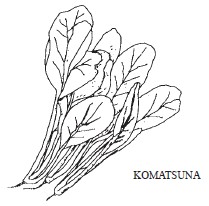
kome こめ 米 rice (harvested but uncooked) Oryza sativa subsp. japonica. The rice grown and eaten in Japan is the short-grained subspecies japonica. It may be non-glutinous (uruchimai 粳米) or glutinous (mochigome 糯米).
komebitsu こめびつ 米櫃 rice bin or chest. Traditionally a wooden box, it is nowadays usually made of metal or plastic.
komugi こむぎ 小麦 wheat Triticum aestivum. Wheat is used in the manufacture of soy sauce and miso. Wheat flour has many uses, including the batter for tempura and cakes such as kasutera.
kona wasabi こなわさび 粉山葵 wasabi powder. Although a very small amount of true wasabi is made into a powder, the great bulk of wasabi powder is not wasabi at all, but powdered horseradish with green coloring and some mustard powder. Even when the paste is made up and sold in tubes, only the more expensive ones have any real wasabi in them. Since the shelf life of these better ones is short, they are not widely sold, and tubes of pure wasabi are not exported at all. If the tube says 100% fresh wasabi, buy it and taste the difference! See also Appendix 16.
konbu こんぶ 昆布 kelp Laminaria spp. The importance of this seaweed in Japanese food life can scarcely be overestimated. It is essential for making dashi stock and is used in innumerable other ways in cooking. Konbu requires cold water and grows off the coasts of northern Japan, especially Hokkaido, where rausu konbu 羅臼昆布, for making dashi, and rishiri konbu 利尻昆布, for general use, are cultivated and harvested in vast quantities at the end of summer. The konbu is dried and cut into lengths of 1 m or more for sale. Specialist shops sell it in such lengths, but supermarkets have to sell it in shorter lengths or folded up. Shredded konbu can be fried and eaten as agemono or itamemono, and shaved konbu, previously soaked in vinegar, is used for making tororo konbu and oboro konbu. Konbu tsukudani is very popular and o-shaburi konbu is chewed, a traditional alternative to gum. Konbu is enormously rich in monosodium glutamate, for which see also Appendix 14.
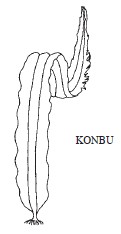
kondate こんだて 献立 menu. The term is especially used for formalized traditional menus such as that of cha kaiseki.
konnyaku こんにやく 蒟蒻、 菎蒻 elephant foot, devil’s tongue Amorphophallus rivieri var. konjac. A gelatinous paste is made from the root of this plant and either formed into bricks or strings. The bricks are usually eaten in simmered dishes, whole in o-den, sliced or broken up in other dishes. A white form is sliced thinly and served as a vegetarian sashimi called yama fugu. Thin strings (shirataki) are used in sukiyaki, and a thicker string is called ito konnyaku. Konnyaku is eaten for its chewy texture rather than its flavor. It should always be briefly boiled before use.
kō no mono こうのもの 香の物 pickle. A formal name for tsukemono.
konoshiro このしろ 鰶、 鯯 gizzard shad Clupanodon punctatus. A large saraine, growing up to 25 cm. A profusion of small bones makes it troublesome to eat. At its best in autumn, it is eaten as sashimi, sushi, sunomono, and shioyaki. In Tokyo the smaller 15-cm fish is called kohada.
konowata このわた 海鼠腸 fermented sea-slug (namako) intestines. This is one of the three delicacies of the Edo period (1603–1868). It can be eaten with a little grated yuzu peel or mixed with grated daikon or chopped quail’s egg. Usually served as a food with drinks (sakana 1). See also karasumi.
konpeitō コンペイトー 金平糖 comfit. A sugar candy introduced by the Portuguese in the sixteenth century, one kind of higashi. It is a small toffee sphere (5 mm in diameter) with a pimply surface, made from sugar, water, and flour, in a variety of colors. Originally there was a sesame seed in the middle, later a poppy seed, but nowadays no seed at all. The word comfit derives from the Portuguese confeito, meaning confection.
konro こんろ 焜炉 portable cooking stove. Charcoal-burning stoves have largely been replaced by gas and electric rings.
koromo ころも 衣 batter and other food coverings and dressings. Tempura batter, egg and bread crumbs for furai, the dressing for aemono, as well as a dusting of sugar are all classed as koromo. However, outside the professional sphere the word koromo is used only for the batter of tempura.
koshiki こしき 漉し器 sieve. Horsehair sieves are available, but usually the mesh is nylon or metal. Also called uragoshi.
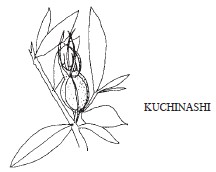
kōshinryō こうしんりょう 香辛料 spice. Among the traditional Japanese spices are asanomi, hemp seeds; goma, sesame; karashi, mustard; keshinomi, poppy seeds; sanshō and kinome, prickly-ash seeds and leaves; shōga, ginger; tōgarashi, chili pepper; wasabi, horseradish; and yuzu, Japanese citron.
koshō こしょう 胡椒 pepper. Not commonly used in Japanese cooking, but mixed with salt (shiokoshō) it is sprinkled on deep-fried chicken.
kōsō こうそう 香草 herb. The main Japanese herbs are benitade, water pepper; seri, water dropwort; shiso, perilla; and mitsuba, trefoil. See also sansai ryōri and nanakusagayu.
kowameshi こわめし 強飯 steamed glutinous rice. The best-known dish of this kind is o-kowa, also called sekihan. It is a celebratory dish that was originally made with red rice (akamai 赤米, usually non-glutinous in Japan). Glutinous rice steamed with other things such as salmon and sansai is often sold in department stores and is also called o-kowa.
kōyadōfu こうやどうふ 高野豆腐 “freeze-dried” tofu. When tofu is frozen and thawed, it becomes very spongy. After it has thawed, it is dried and then reconstituted in water for use. Being spongy, it is a good absorber of flavors. It is much used in maki-zushi and shōjin ryōri.
kuchinashi くちなし 梔子 gardenia Gardenia jasminoides. The flowers, which bloom in June and July, are used as a garnish for sashimi. The dried pods are used for an orange-red coloring for such things as takuanzuke and sweet-potato kinton.
kujira くじら 鯨 whale Balaenoptera spp.; Balaena spp. Whale meat is available in some markets and there are restaurants that specialize in whale-meat dishes, notably one at Shibuya in Tokyo.
kurage くらげ 水母、 海月 jellyfish 1. echizen kurage (Stomol-ophus nomurai) 2. bizen kurage (Rhopilema esculenta). The Echizen jellyfish, about 1 m in diameter, is about twice the size of the Bizen. Jellyfish is salted and then dried in the sun. It is mostly used in sunomono after the salt is soaked out. Having little if any flavor, kurage is enjoyed for its crunchiness.
kuri くり 栗 chestnut Castanea crenata. Chestnuts are greatly enjoyed in Japan and used in many sweet confections such as kinton. However, the local chestnut is very difficult to peel and most of the chestnuts consumed are imported from China. Amaguri (sweet chestnuts) are made by roasting chestnuts in a tub of revolving hot pebbles. Brown sugar or syrup is added to increase the sweetness by permeating the skin and at the same time makes the skin easier to remove with the fingernails. This is especially useful since amaguri are often sold in places of outdoor leisure.
kuri kinton くりきんとん 栗金団 See kinton.
kurodai くろだい 黒鯛 black bream, black porgy Acanthopagrus schlegeli. Growing about 40 cm long, it is at its best in April. It is not suitable for sashimi because of its “marine” smell, but is extremely good as shioyaki.
kuromame くろまめ 黒豆 black soybeans Glycine max. Sold in the dried form, these beans are soaked, boiled till tender, and sweetened. An essential ingredient of the New Year o-sechi ryōri.
kuruma ebi くるまえび 車海老 tiger prawn Penaeus japonicus. See also ebi.
kurumi くるみ 胡桃 common walnut Juglans regia. Walnut paste makes a delicious koromo for aemono. Otherwise, walnuts are extensively used in confectionary, usually broken into small pieces.
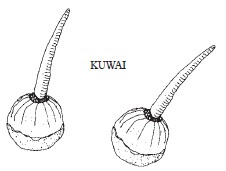
kushi くし 串 skewer. Fish are carefully skewered for grilling on metal skewers. Bamboo skewers are used for yakitori, kushiyaki (skewer grilling), and the extremely tasty kushiage, in which all kinds or ingredients are coated with egg and bread crumbs, skewered, and deep-fried.
kuwai くわい 慈姑 arrowhead Sagittaria trifolia var. edulis. This plant, which grows in shallow water, has a bulb 3 to 5 cm in diameter, with a pointed protuberance about 4 cm long. To eat, it is peeled, boiled, and seasoned. It is often served as nimono and features in the New Year o-sechi ryōri. Kuwai is rich in protein and has a somewhat waxy texture.
kuzu くず 葛 kudzu Pueraria lobata. A high-quality thickening starch is made from this vine. The starch is made in many parts or Japan but the most famous kuzu comes from Yoshino in Nara Prefecture. It is used to make sesame tofu (goma dofu) and a kind of sōmen and has many other uses.
kyōdo ryōri きょうどりょうり 郷土料理 local cuisine. There is an enormous variety of local styles of cooking throughout Japan, hardly surprising when the great variations in climate and other local differences are considered.
kyōna きょうな 京菜 pot herb mustard Brassica campestris var. lanciniifolia. A versatile green leaf vegetable associated with Kyoto. It is closely related to mizuna and has beautiful, shiny, feathery leaves growing in clumps. May be used in soups and pickles as well as aemono, nimono, and nabemono.
kyō ryōri きょうりょうり 京料理 Kyoto cuisine. Kyoto was not only the capital of Japan for many centuries, but was (and still is) the home of Buddhism. This meant that not only did high-class, elegant cookery such as cha kaiseki flourish, but so also did shōjin ryōri, the Buddhist vegetarian cuisine. In fact, vegetables, especially pickles, are a notable feature of Kyoto’s food culture, not least because the city was too far from the sea to get good fish in the days before refrigeration. Kyoto is also famous for its elegant bentō and its high-quality higashi.
kyūri きゅうり 胡瓜 cucumber Cucumis sativus. Japanese cucumbers are small and without the coarse seeds that are such a drawback of the Western cucumber. They can be eaten raw, but are usually prepared as sunomono or tsukemono.
kyūsu きゅうす 急須 teapot. Mainly used for serving sencha, it is a small pot made of pottery or china, with a lug for a handle, or no handle at all. See also cha.
ma- ま- 真- prefix meaning true, proper. It is often attached to the most representative species of an animal or plant, e.g., ma-aji and ma-konbu.
mabikina まびきな 間引菜 young shoots (cotyledon) of green vegetables and herbs. Kaiware is one kind of mabikina.
maguro まぐろ 鮪 tunny, tuna, bluefin tuna Thunnus thynnus. A very large fish, growing to between 1 m and 3 m and up to 700 kg or more in weight. At its best in June but very good at any time, it makes superb sashimi and sushi. The pale ventral meat (toro), rich in oil, is the most highly regarded. If maguro has to be cooked, then shioyaki and teriyaki are the best ways, though it is also good as nimono.
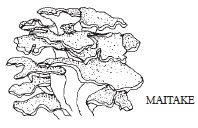
maitake まいたけ 舞茸 hen-of-the-woods fungus Grifola frondosa. An autumn fungus, it is very fragrant, truly delicious, versatile, popular, and extensively cultivated. It is also more suitable for Western cooking than most Japanese mushrooms, being very good in an omelet. In Japanese cookery, it goes well in rice dishes, soups, and nimono. Best of all is maitake no kurumi ae, a dressed salad (aemono) with walnut paste as the koromo.
makisu まきす 巻き簾 bamboo mat for rolling sushi.
makizushi まきずし 巻き鮨、 巻き寿司 sushi roll. With a filling of kanpyō, mitsuba, omelet, mushrooms, and kōyadōfu, sushi rice is rolled in a sheet of nori with a makisu. This is cut into thick slices and eaten as is or dipped in soy sauce.
makunouchi bentō まくのうちべんとう 幕の内弁当 boxed meal originally for eating in the intervals between Kabuki plays. It has become a good standard bentō for any occasion, in which rice, sprinkled with sesame seeds, is accompanied by a variety of tidbits, usually ten or more different kinds.
mame まめ 豆 bean. The term includes peas, but above all refers to the soybean.
mame moyashi まめもやし 豆萌やし、 豆糵 bean sprouts. The commonest ones are those made from mung beans (ryokutō), but the larger sprouts of soybeans are also readily available. Moyashi are extensively used in tsukemono and nabemono.

managatsuo まながつお 真魚鰹、 鯧 silver pomfret, butterfish Pampus argenteus. An excellent food fish, at its best in winter. It grows to a length of about 50 cm. Best eaten as sashimi, it is also prepared as teriyaki and misozuke. It is widespread in the waters of southern Asia.
manaita まないた 俎板、 爼 chopping board. The traditional Japanese ones were (and still are) on two horizontal struts.
manjū まんじゅう 饅頭 sweet bun. Usually steamed, leavened wheat- or rice-flour buns filled with an (anman), pork (butaman), or even curry (karēman). A very popular snack sold and eaten hot. These buns are the same as some kinds of Chinese dim sum.
marumero マルメロ quince Cydonia oblonga. This is the European and Middle Eastern quince, introduced into Japan about 1620. Its uses are the same as those for karin but it does not have the same astringency. The Japanese word is derived from the Portuguese marmelo, meaning quince.
maruyaki まるやき 丸焼き grilling in the piece. This can refer to anything from a whole chicken to a whole pig, indeed anything that has not been cut up.
masu 1. ます 鱒 cherry salmon, masu salmon, sakuramasu Oncorhynchus masou masou. The sea-run form of this fish is predominant in northern Japan, whereas the freshwater form (yamame) is predominant in western Japan. Masu attains about 60 cm and about 15 kg and is a very good eating fish, cooked in any of the ways salmon is cooked. Shioyaki is very good.
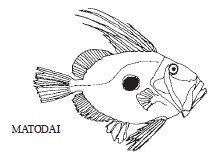
masu 2. ます 析、 升 measure for volume; and for drinking saké. Traditionally these were wooden boxes of standard size. They have been supplemented with metal and plastic cups.
matcha まっちゃ 抹茶 powdered green tea. See also appendices 12 and 13.
matōdai まとうだい 的鯛 John Dory Zeus faber. This excellent eating fish attains 50 cm and is found south of Fukushima Prefecture. It has an enormous mouth and a big black spot on its side. It is best in winter and is very good as teriyaki and misozuke.
matsubagani まつばがに 松葉蟹 matsuba crab, Pacific snow crab, queen crab Chionoecetes opilio. This is the San’in (western Japan on the Japan Sea side) name for zuwaigani.
matsutake まつたけ 松茸 matsutake fungus Tricholoma matsutake. For those who can afford it, eating good-quality matsutake in autumn is one of the great experiences of life. It is very good in rice, even better in dobinmushi, and some say grilled in foil, best of all. There is a certain ribaldry about young men and women going hunting for matsutake, since it is quite phallic in shape, and the chances of getting lost in the woods of red pine where it grows are quite high. Matsutake is very hard to find and is imported on a large scale, especially from Korea.
mebaru めばる 眼張 rockfish, Japanese stingfish Sebastes inermis. Found in the coastal waters all around Japan, it attains a length of 30 cm and is best to eat in March. It is prepared as nitsuke, teriyaki, and kara-age.
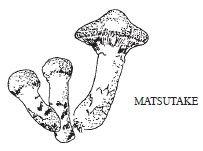
mejina めじな 眼仁奈 large-scale blackfish, luderick Girella punctata. Very similar in appearance to black bream but at 50 cm a bit larger, it is a coastal fish found from Hokkaido to the East China Sea. Tastiest in winter, it is best eaten as sashimi, shioyaki, and nitsuke.
menbō めんぼう 麺棒 rolling pin. The long (1-m) thin ones for rolling noodles are best made of oak.
menma メンマ 麺碼、 支那竹 See shinachiku.
men rui めんるい 麺類 noodles. Noodles form a significant part of Japanese food culture. Various kinds are available, the main ones being udon, soba, rāmen, kishimen, and sōmen.
mentai めんたい 明太 See suketōdara.
mentaiko めんたいこ 明太子 Alaska pollack roe. A speciality of Hakata in Kyushu, the roe is salted and flavored with chili pepper. It is usually colored a deep red. Also called karashimentai or karashimentaiko, the karasni being tōgarashi.
meshi めし 飯 informal word for cooked rice or a meal.
mikan みかん 蜜柑 mandarin, tangerine Citrus unshiu. Frequently but mistakenly referred to as Citrus reticulata, which in Japanese is ponkan. Mandarins are a very popular winter fruit and are consumed in vast quantities as a snack.
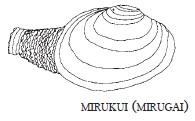
mirin みりん 味醂 sweet liquid flavoring. It is made by mixing steamed glutinous rice on which rice mold, Aspergillus oryzae, has developed, with shōchū (distilled spirits). In forty to sixty days sweetness develops, the resulting liquid containing 14% alcohol. It is exclusively used in cooking, for its sweetness rather than its alcoholic flavor. Regular saké is no substitute and it is incorrect and misleading to call mirin “a kind of sweet cooking saké.” It is important to distinguish between genuine mirin and low-alcohol imitation mirin. The real thing, hon mirin, is sold at saké shops and good supermarkets.
mirinboshi みりんぼし 味醂干し small fish such as kisu, aji, and iwashi flattened open, seasoned with a marinade of mirin, soy sauce, and sugar, and then dried. Sometimes sesame seeds are sprinkled over them. They make a good tsumamimono, and are the better for being lightly grilled.
mirugai みるがい 海松貝、 水松貝 mirugai clam, gaper Tresus keenae. Sometimes incorrectly called bakagai, this clam-shaped bivalve is about 14 cm across and 9 cm thick. A large syphon projects from the shell. It is prevalent in all the shallow waters around Japan. The syphon is eaten, after being skinned, as sushi, sashimi, and sunomono. It is very chewy. The intestines, adductor muscle, and foot are also eaten but are inferior in flavor. The name mirugai is a popular misnomer for mirukui.
mirukui みるくい 海松食、 水松食 the correct name for miru-gai. Mirukui means eater of sea staghorn, a seaweed (Codium fragile), miru in Japanese, because that is what this shellfish does.
miso みそ 味噌 miso is a fermented paste of soybeans and usually either barley or rice, with salt. Its prototype came to Japan from the Asian mainland sometime between the sixth and seventh centuries. Miso is an essential Japanese foodstuff that is highly nutritious and is not only a basic of cooking, above all in miso soup, but is also often used as a flavoring. Both in taste and aroma, miso is highly savory, almost meaty, having about 14% high-quality protein and 5 to 12% salt. See also Appendix 6.
misoni みそに 味噌煮 long gentle simmering with miso. It is a kind of a nimono, and is especially used with fish such as ei and saba.
miso shiru みそしる 味噌汁 miso soup. In this basic Japanese soup, dashi is thickened with miso, and fish, vegetables, and such things as tofu are added. It is not necessary to use the best dashi, and awasemiso is considered to give the best flavor. Shellfish in the shell and fish on the bone are used, and the vegetables should not throw off scum, as burdock does. Tofu, kōyadōfu, and abura-age go well, as do both fresh and dried fu. Miso soup is essential to a Japanese breakfast and is served at most other meals as well. It is a good source of protein, especially in conjunction with the eating of rice.
misozuke みそづけ 味噌漬け miso pickles. Suitably sized whole vegetables and fish or meat are pickled in a bed of miso, the length of time varying from a couple of hours to as much as a month. The vegetables are eaten as pickles (tsukemono), and the fish or meat is grilled or cooked in other ways.
mitarashi dango みたらしだんご 御手洗団子 rice-flour dango. These balls are a speciality of the Shimokamo shrine in Kyoto. Five balls are put on a skewer and grilled with a basting of soy sauce. The ball at the tip, representing a human head, is larger than the others, which are the body. They are given as offerings at weddings at the shrine.
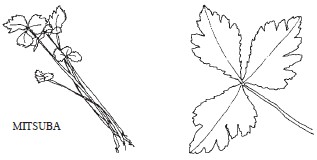
mitsuba みつば 三つ葉 trefoil, Japanese wild chervil Cryptotaenia japonica. Mitsuba is used as herb in soups, salads, and with vinegared and fried foods. It derives its name, literally three leaves in Japanese, from the three leaflets that make up the leaf. It is very similar in appearance to seri and coriander (not used in Japanese cooking at all) but totally different in its flavor, which is that of a mild chervil.
mitsumame みつまめ 蜜豆 popular sweet dish. Various things, including small pieces of fruit and sweet beans, are placed in a bowl with cubes of kanten. Syrup, either clear or dark, is poured over the top. When the an of azuki is included, it is called anmitsu.
mizuame みずあめ 水飴 glucose (syrup). Used in making candies and jam.
mizuna みずな 水菜 pot herb mustard Brassica campestris var. lanciniifolia. See also kyōna.
mizutaki みずたき 水炊き chicken nabemono. Roughly chopped chicken on the bone (butsugiri) is simmered in a communal pot with seasonal vegetables and such things as tofu and bean sprouts. When ready, they are dipped in ponzu and eaten. Lastly mochi or udon may be simmered in the delicious remaining stock.
mochi もち 餅 rice cake. Glutinous rice is steamed, pounded into a paste, and shaped into cakes. Traditionally, in eastern Japan the cakes are cut with a knife (kirimochi), in western Japan they are shaped into circles by hand. In recent years this distinction has become less clear-cut. In either case they are eaten as is while still soft, and when they become hard are toasted and served in many ways, such as with nori or soy sauce or sugar. They are one of the essential Japanese foods, and having a celebratory significance, are particularly eaten at New Year, when many people try to eat a lot of them. They are served in zōni, the special New Year soup. They are very soft and sticky and every year a number of people, usually old people, choke to death on them.
mochigome もちごめ 糯米 glutinous rice Oryza sativa subsp. japonica Glutinosa Group. The regular rice eaten by the Japanese is not, as is so often stated, glutinous rice, but non-glutinous rice (uruchimai). Glutinous rice is largely reserved for special occasions and has to be steamed in a steamer. The principal glutinous-rice preparation, apart from all kinds of mochi, is sekihan.
momendōfu もめんどうふ 木綿豆腐 See tōfu.
monaka もなか 最中 stuffed wafer cake. A kind of wagashi, dating from the early nineteenth century, in which rice is made into a very light wafer, which is stuffed with an. There is a variety of shapes and sizes and also of the kinds of an used.
moriawase もりあわせ 盛り合わせ See moritsuke 5, mazemori.
morijio もりじお 盛り塩 pile of salt. From the earliest times salt has been associated with ritual purity in Japan, and little piles of salt have been placed at shrines to purify and gain the gods’ protective presence. The Grand Shrine of Ise, finding modern salt quite unsatisfactory for this purpose, has maintained its own salt terrace (mishiohama 御塩浜) to produce salt in the traditional way. A quite different custom is found in entertainment districts, where morijio is sometimes placed outside the entrance to a bar, and is intended to attract customers to enter. The custom originated in China with carriage oxen stopping to lick the salt. See also Appendix 8.
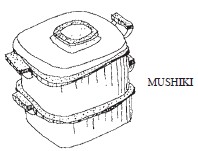
moritsuke もりつけ 盛り付け food arrangement. There are basically seven formalized ways of arranging food on a plate, governed by the foods to be arranged and the vessels to be used. The seven are 1. sugimori, strips and slices of food in a slanting pile; 2. kasanemori, slices placed overlapping each other; 3. tawaramori, blocks or rounds placed horizontally in a pyramid; 4. hiramori, flat slices of sashimi arranged vertically; 5. mazemori, a mixed pile of different-colored thin strips. (Also, with foods such as nigirizushi, a representative selection arranged on a plate. For nigirizushi, see also Appendix 11.); 6. yosemori, two or three contrasting ingredients arranged next to each other; 7. chirashimori, like yosemori but with space between the ingredients. Less common than these seven is takamori in which the ingredients are piled high above the vessel. It is nowadays restricted to service of the gods and the emperor. See also ōmori.
morokyū もろきゅう sliced cucumber spread with moromi of soy sauce. Hishio, when available, is often used instead of moromi. So also is kinzanji miso, for which see also Appendix 6. Morokyū is served as tsumamimono or zensai.
moromi もろみ 1. 醪 unfiltered saké. 2. 諸味 unfiltered soy sauce. In both cases moromi refers to the product at a stage prior to filtration. Soy-sauce moromi has several uses in cooking.
moromi miso もろみみそ 諸味味嗜 chopped, salt-pickled vegetables are added to moromi 2 made with less water than usual, and miso starter mold, Aspergillus oryzae, is added. The final product is dark brown in color and soft in consistency, and mostly eaten on slices of cucumber.
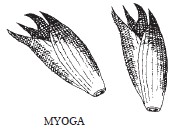
motsu もつ giblets, entrails. Motsunabe is a kind of nabemono in which several kinds of viscera are used.
moyashi もやし 萌やし、 糵 See mame moyashi.
mozuku もずく 水雲、 海蘊 mozuku Nemacystis decipiens. A dark brown seaweed with filaments 30 to 40 cm long, which is preserved in salt and eaten as tsumamimono. It also makes very good sunomono.
mugi むぎ 麦 grain. Wheat, barley, oats, and rye are all mugi, but without qualification mugi generally means barley. Mugicha is a refreshing infusion of roasted barley, very popular as an iced drink in summer. See also Appendix 12.
mugi kogashi むぎこがし 麦焦がし parched barley flour. See also ōmugi.
mukōzuke むこうづけ 向こう付け first course. This is the namasu or sashimi of kaiseki ryōri. The Japanese word refers to the position of the dish on the tray, opposite the bowls of rice and soup.
murasaki むらさき 紫 soy sauce. A sushi-shop word basically meaning purple.
muroaji むろあじ 室鯵、 鰘 brown-striped mackerel scad Decapterus muroadsi. This elegant fish attains a length of about 40 cm in the waters of western and southern Japan. It is eaten as sashimi and shioyaki and made into a kind of himono (dried fish) called kusaya.
mushiki むしき 蒸し器 steamer. The term generally refers to a modern-style metal steamer rather than the traditional wooden or bamboo seirō.
mushimono むしもの 蒸し物 steamed food. The best-known steamed dishes are chawan mushi and tamago dōfu. There are also many excellent dishes of steamed seafood. A particularly good refinement is sakamushi, in which saké is poured over the ingredients before steaming.
musubi 1. むすび 結び a kind of knot or tie used to decorate food. Ingredients knotted include kisu and mitsuba.
musubi 2. むすび 結び rice ball. Cold rice is formed into balls with a stuffing of something with a strong flavor, such as bai niku, katsuobushi, salmon, or chopped pickles. A strip of nori is often placed around the rice, or it can be sprinkled with sesame seeds. Rice balls are handy for picnics and school lunches. Also called nigirimeshi 握り飯 and popularly o-nigiri おにぎり.
mutsu むつ 鯥 Japanese bluefish Scombrops boops. This large-eyed, wide-mouthed fish, which attains up to 60 cm, is tastiest in very cold weather, when its fat content increases. It is eaten as sashimi, nitsuke, and teriyaki and is very good simmered in miso.
mutsugorō むつごろう 鯥五郎 blue spotted mud-hopper, pondskipper Boleophthalmus pectinirostris. This fish is a kind of goby found in the coastal waters of western Japan. It grows to only about 15 cm in length, but in late spring and early summer, when its body fat increases, it is quite tasty grilled, particularly as kabayaki.
myōga みょうが 茗荷 mioga Zingiber mioga. Although mioga is a kind of ginger, it is scarcely recognizable as such, since only the buds and stems, not the rhizome, are eaten. The buds are very fragrant when thinly sliced and are used as a garnish. Both buds and stems are made into vinegar pickles, the pickled stems being used as a garnish for grilled fish in the same way that pickled ginger stems (hajikami) are used. Mioga is not hot like ginger, the fragrance being more herbal. Sliced, it makes an excellent addition to a salad.
















 Atka mackerel
Atka mackerel 





















